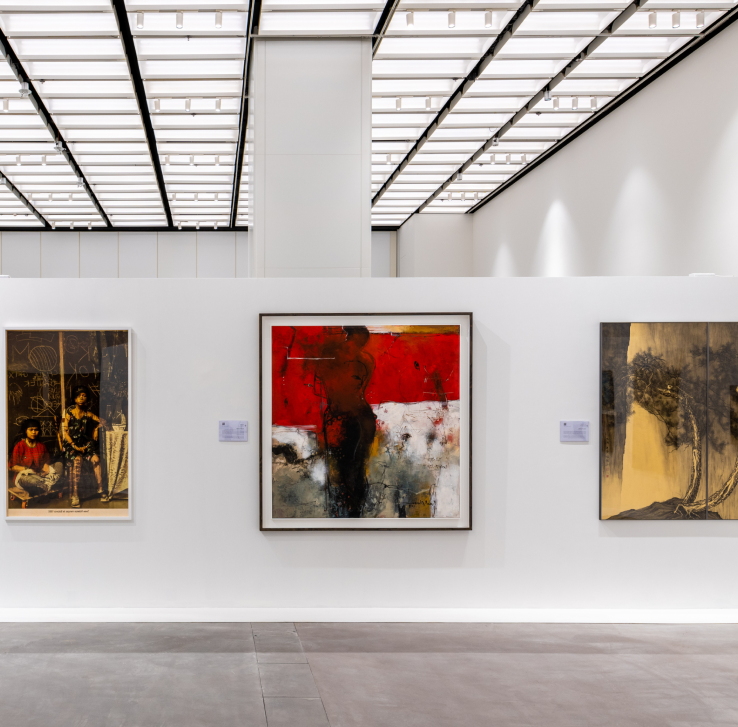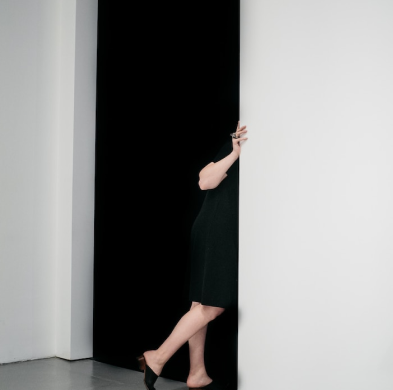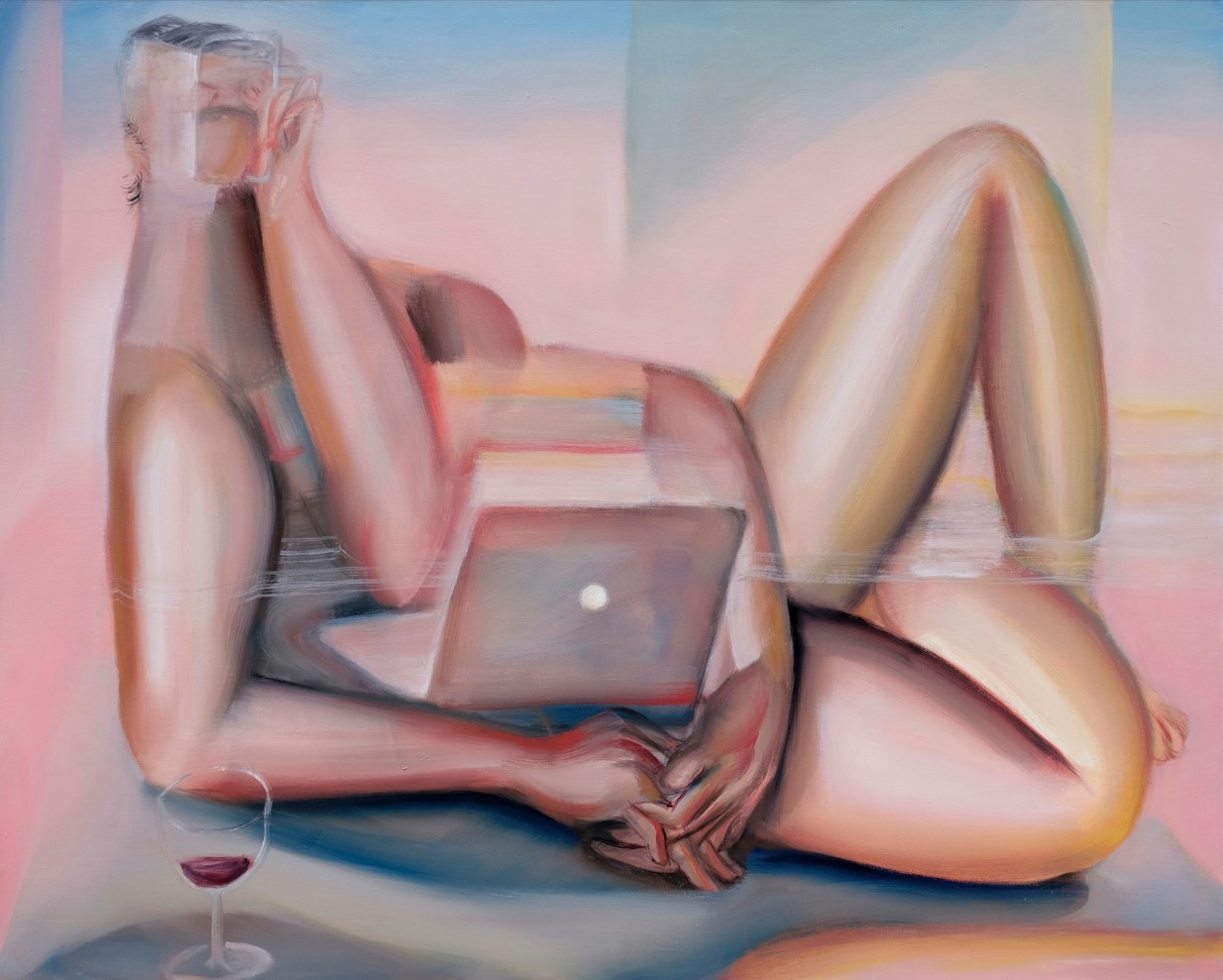

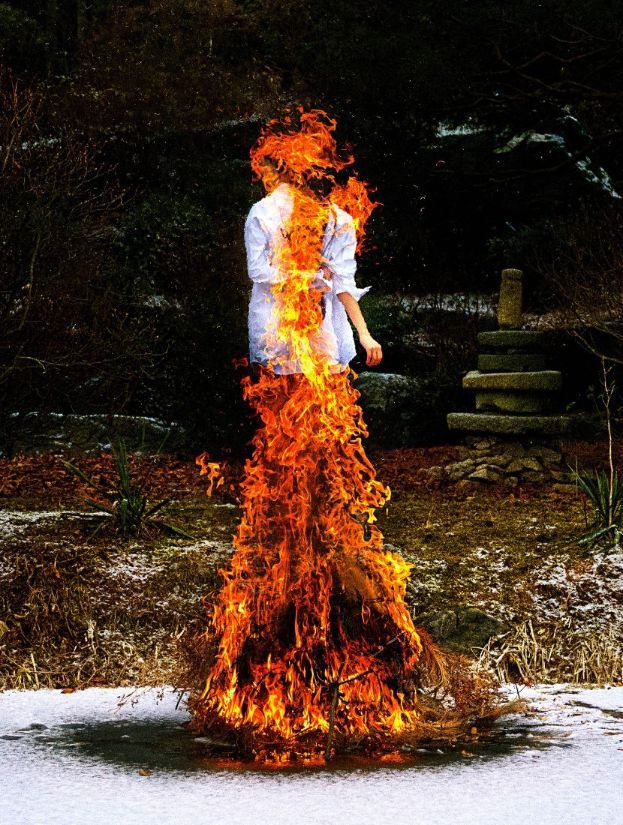
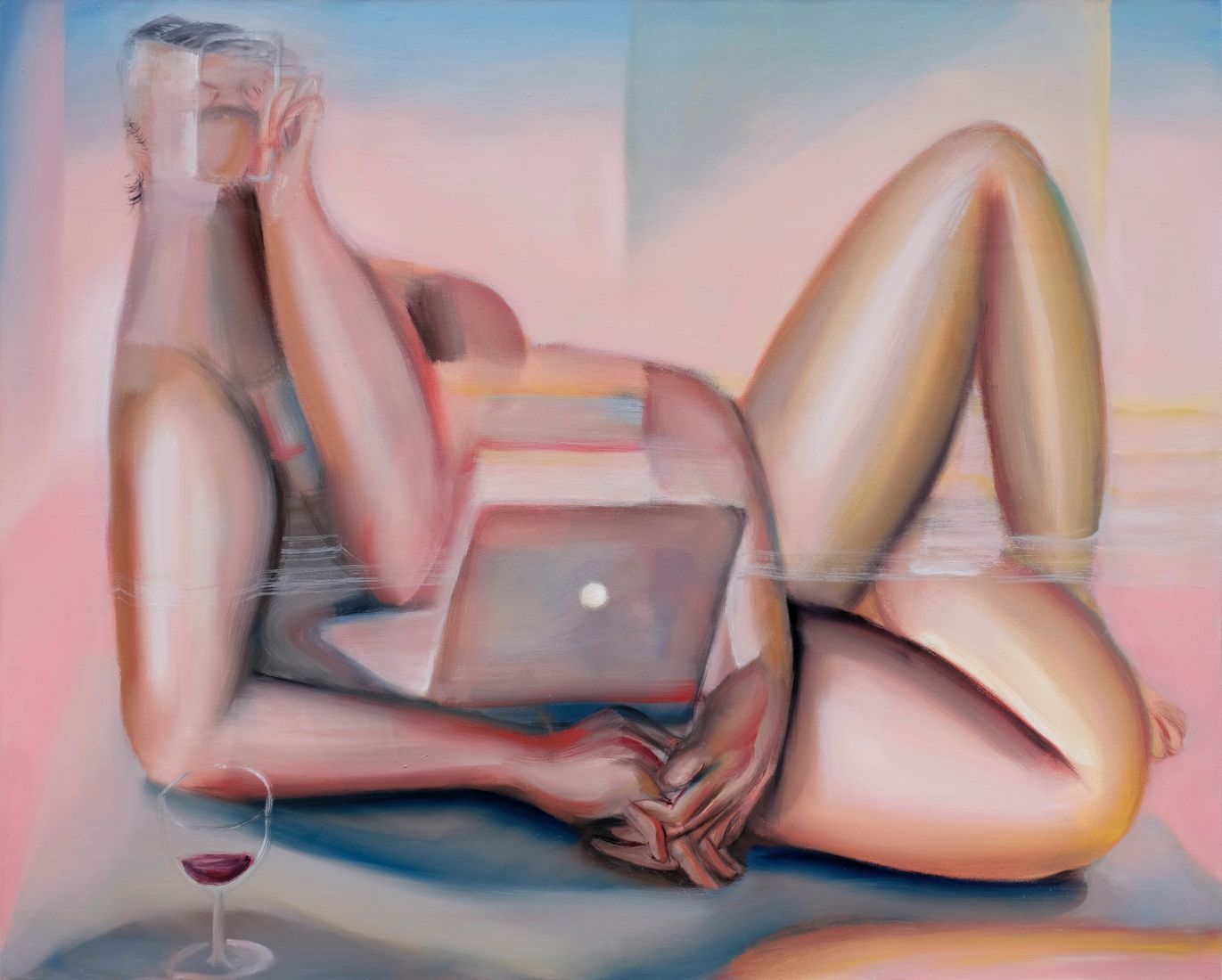
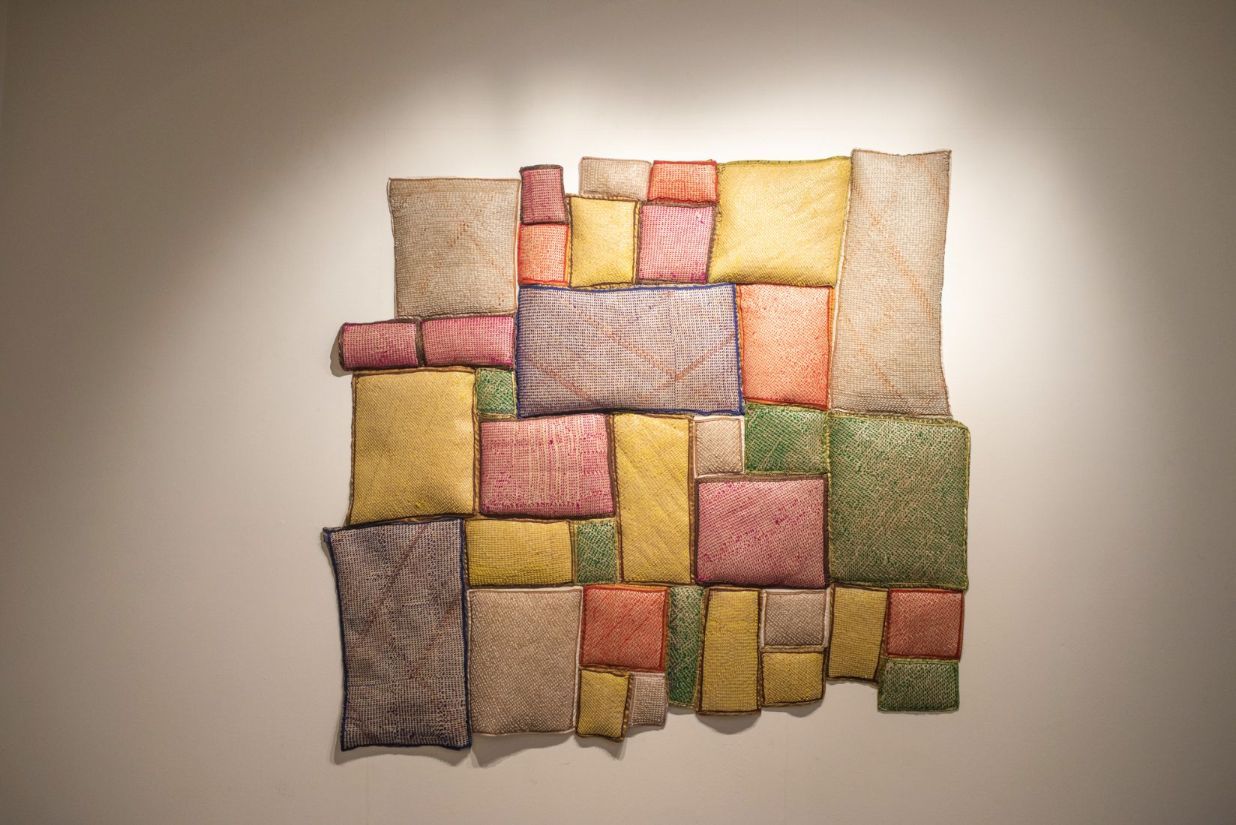
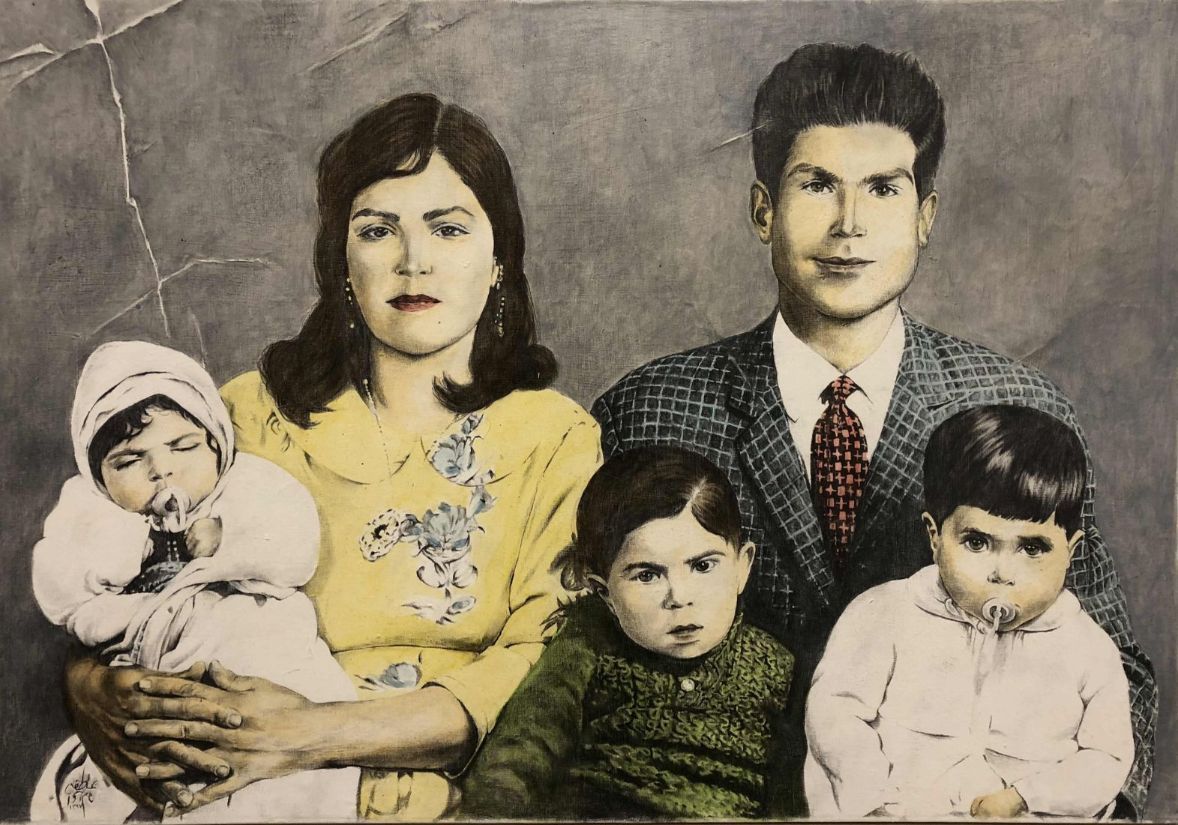
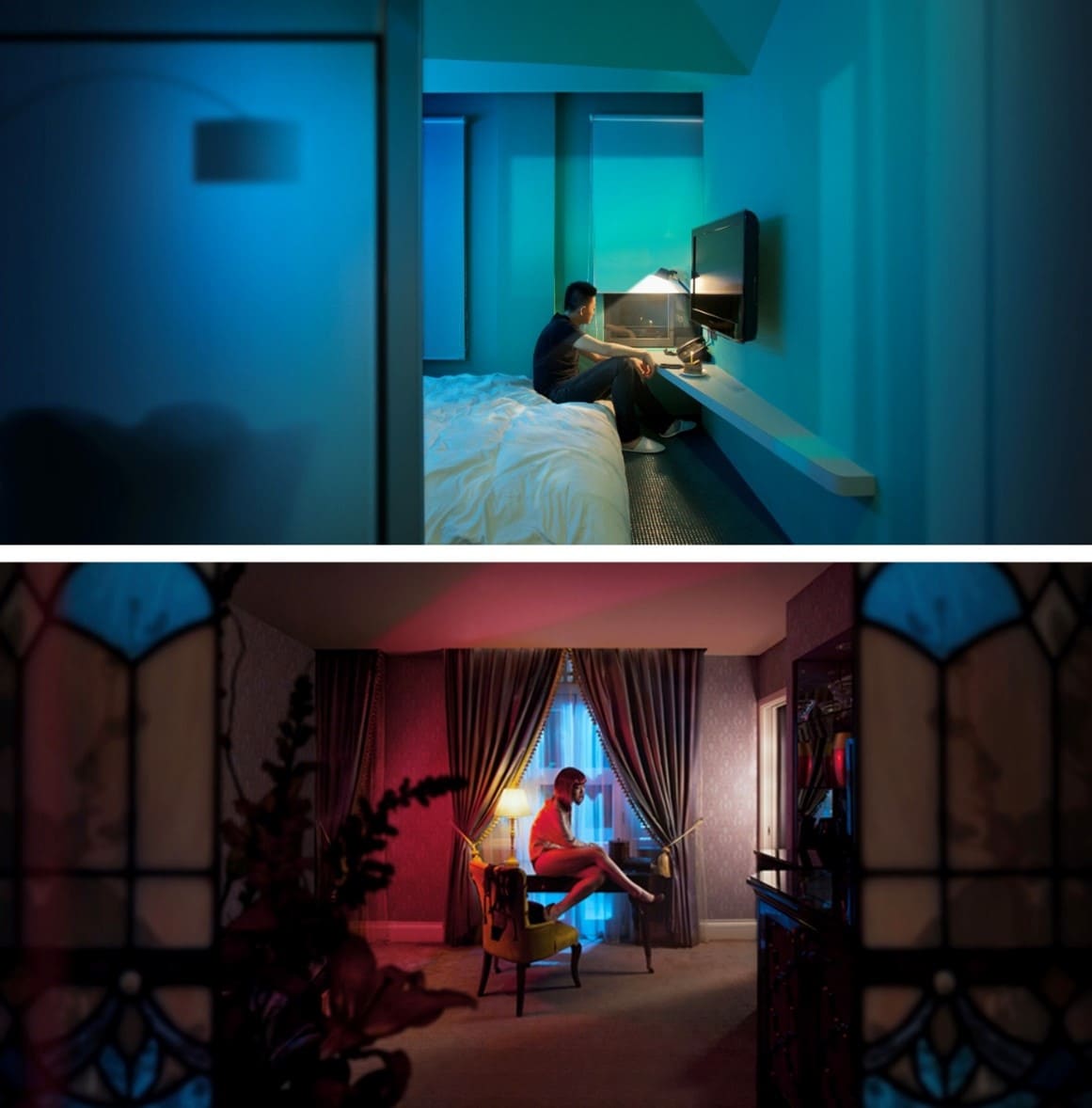
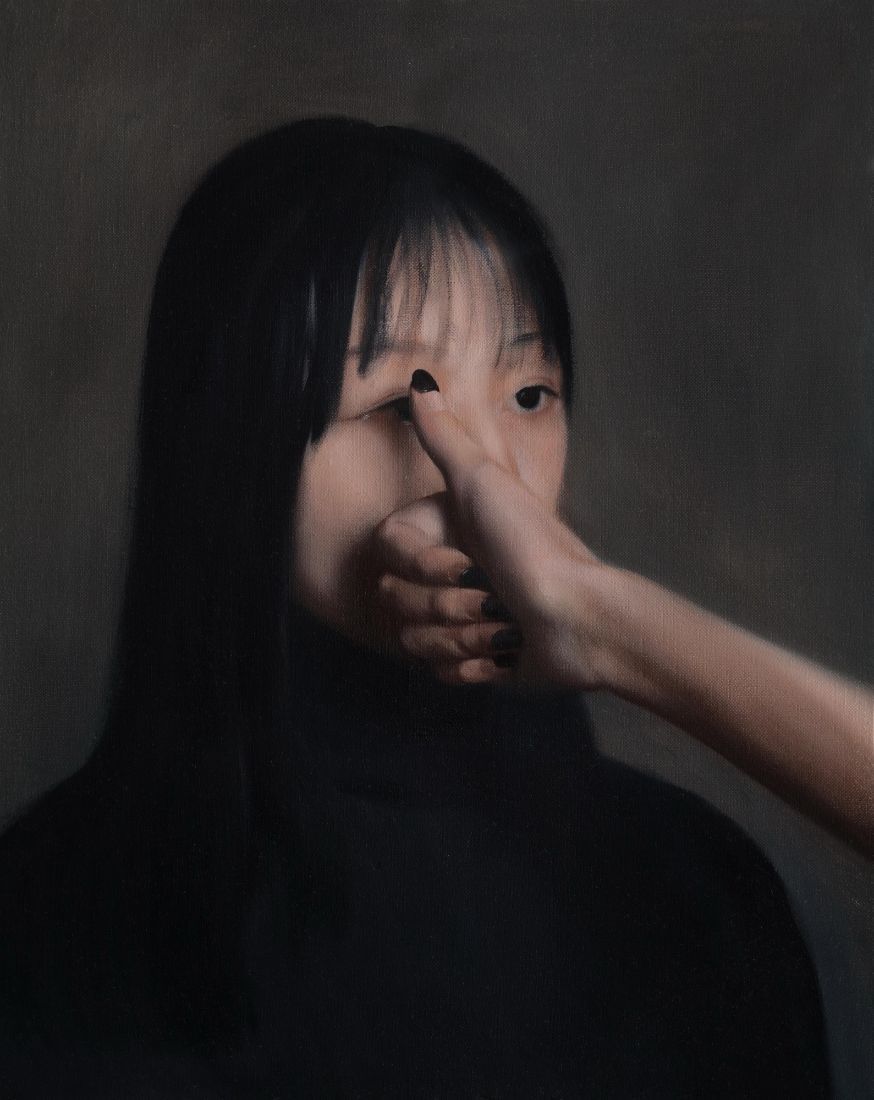
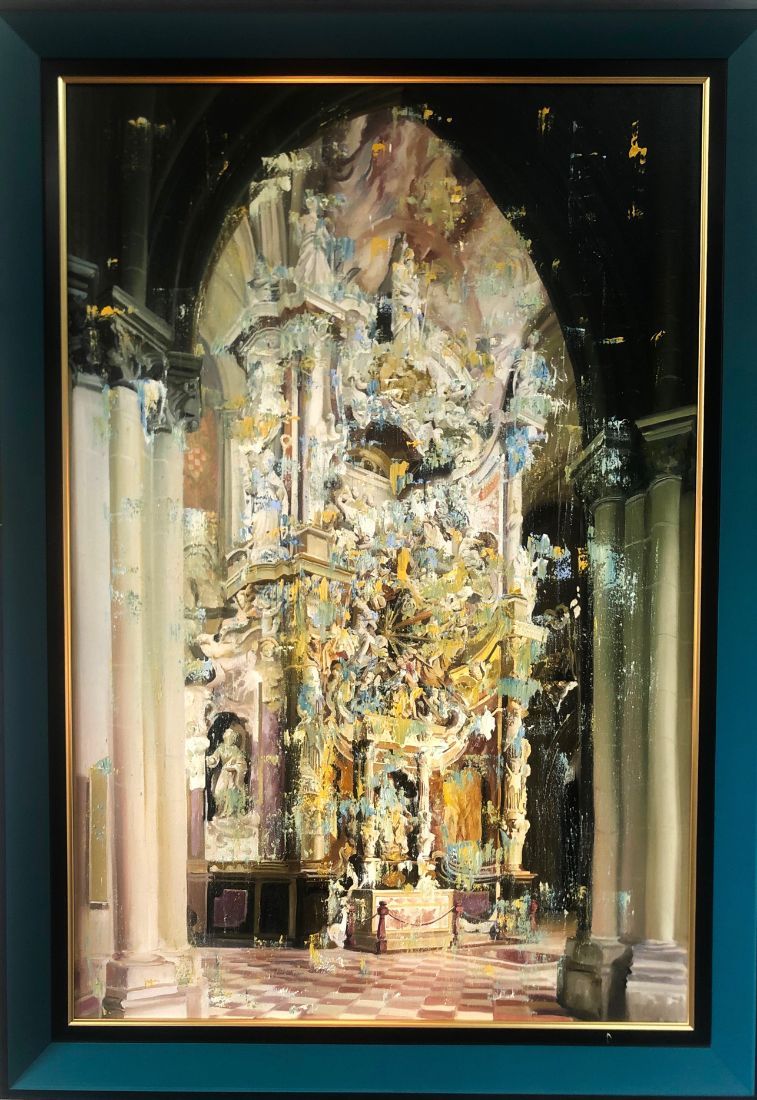
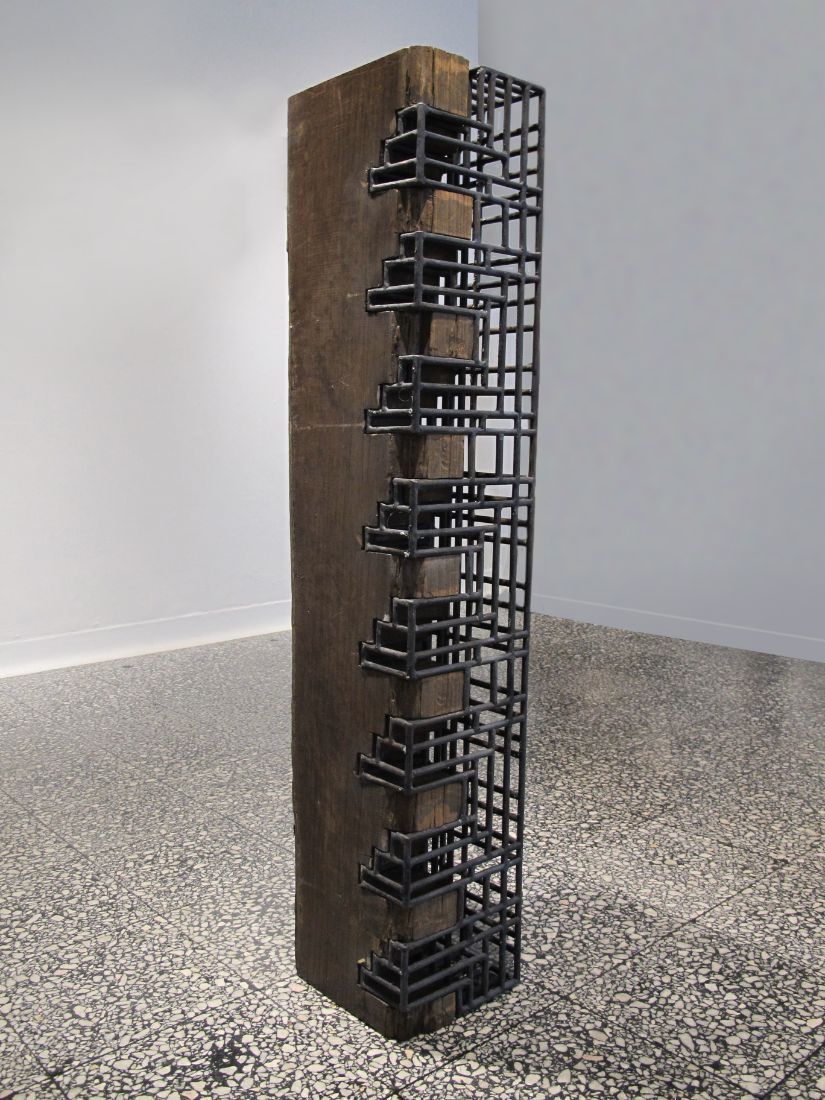
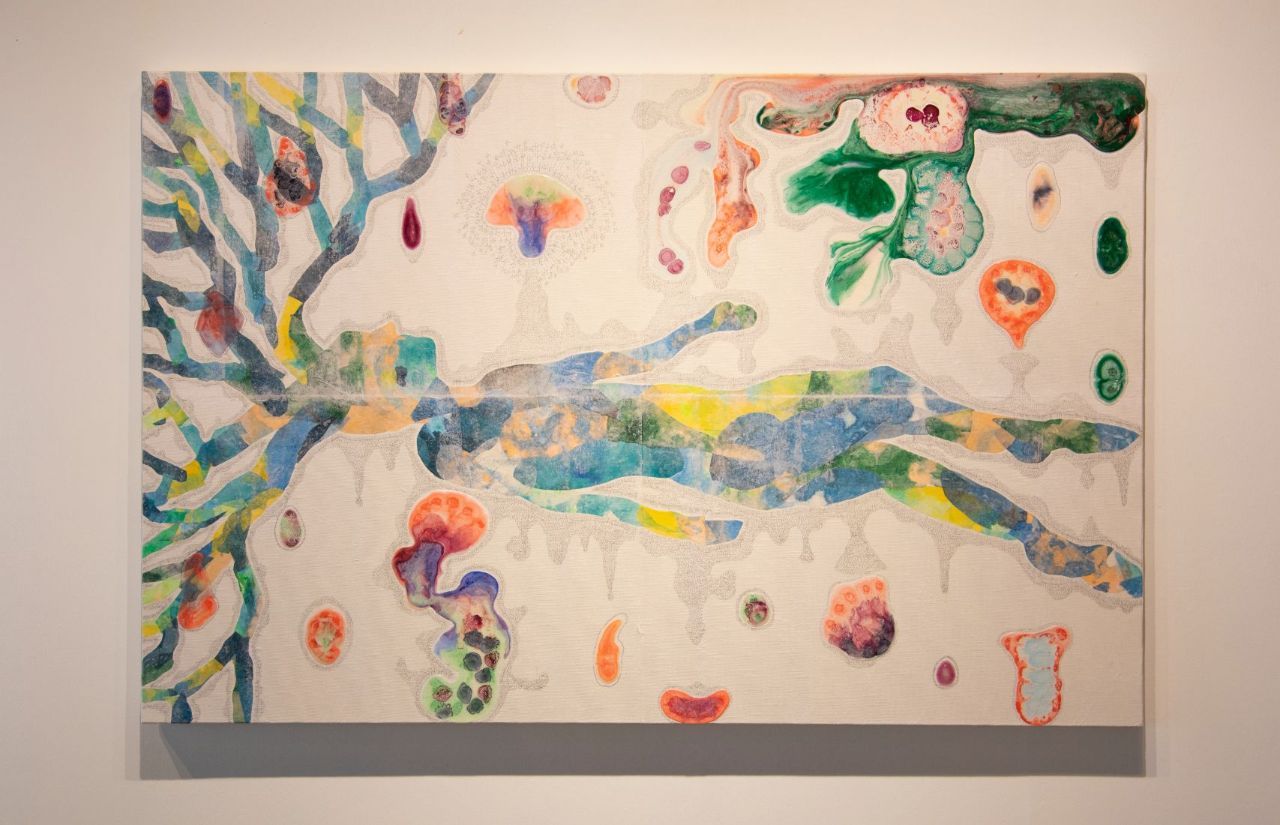
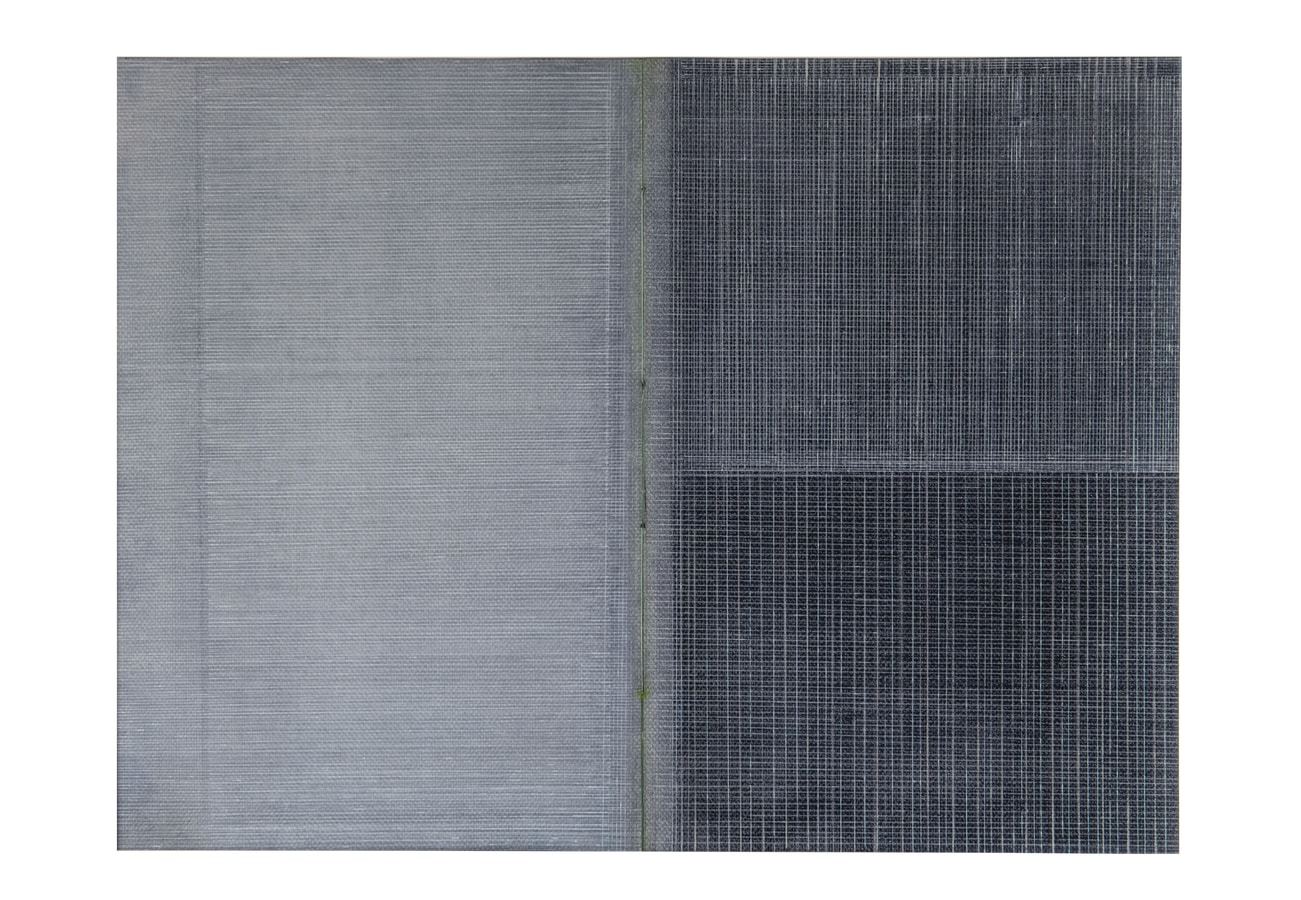
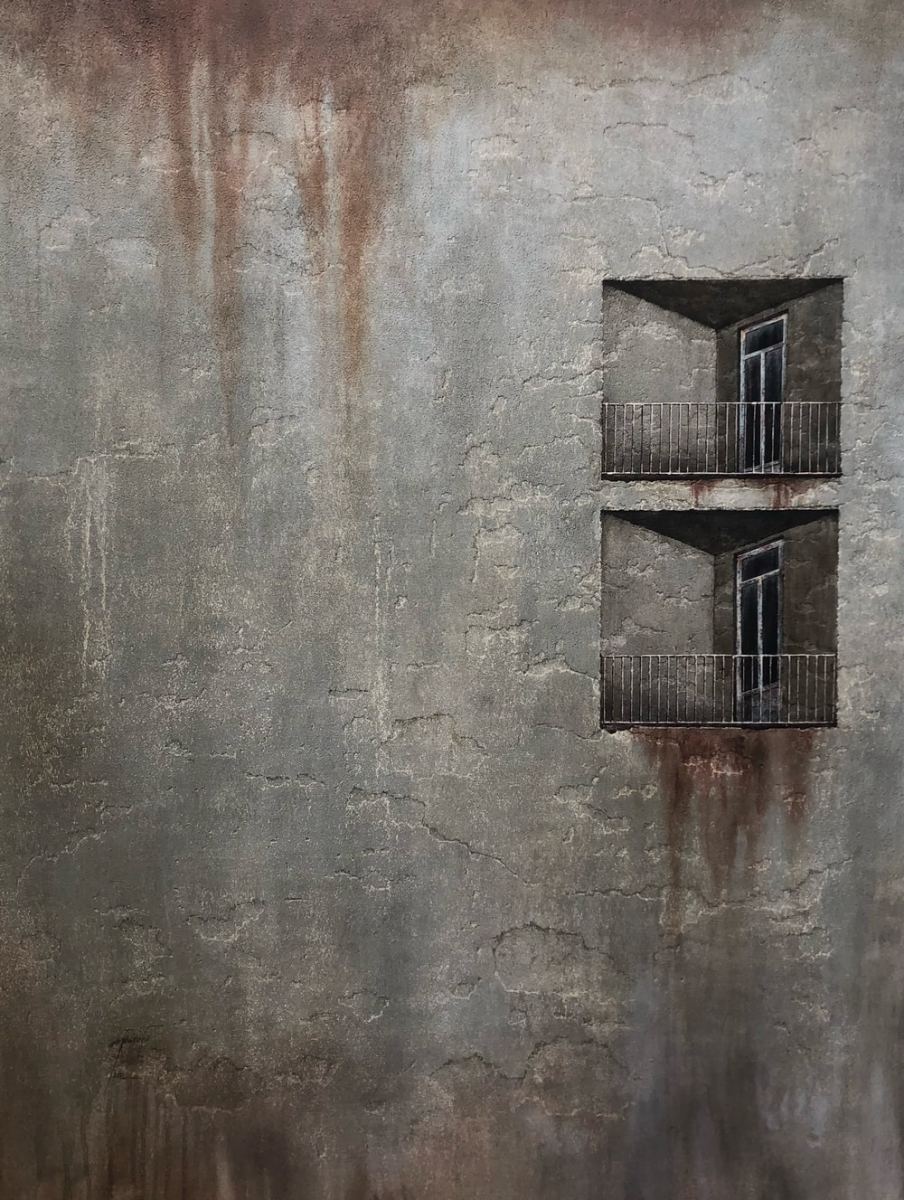
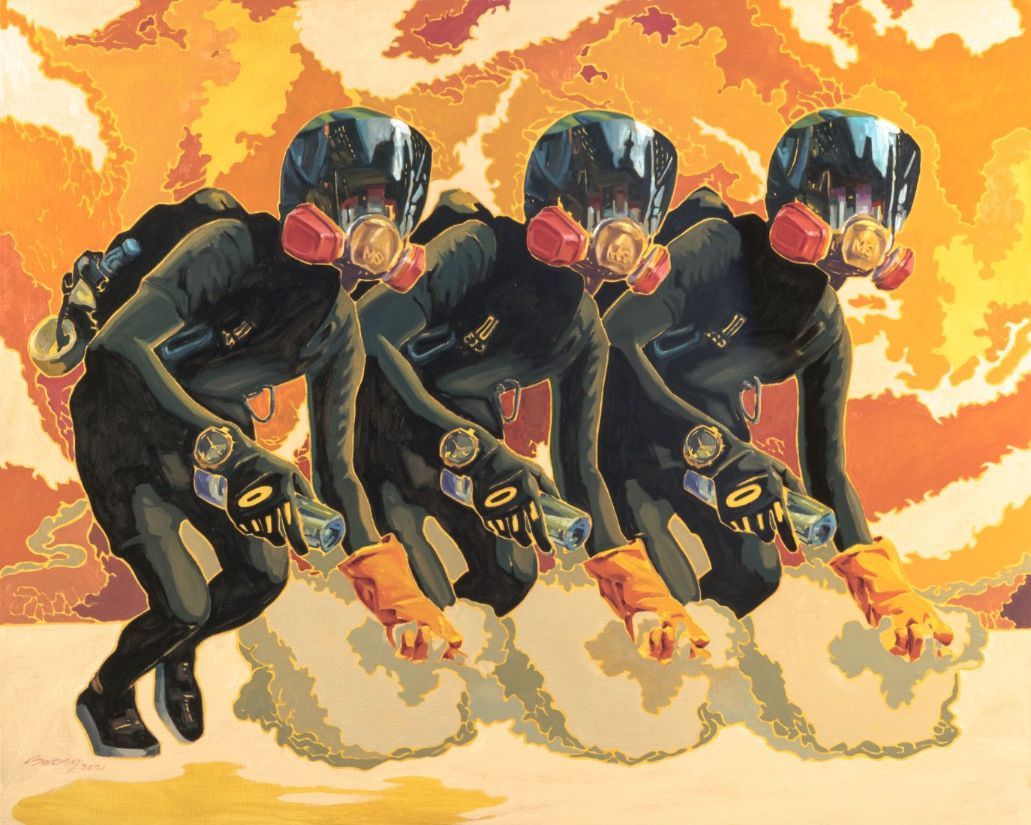
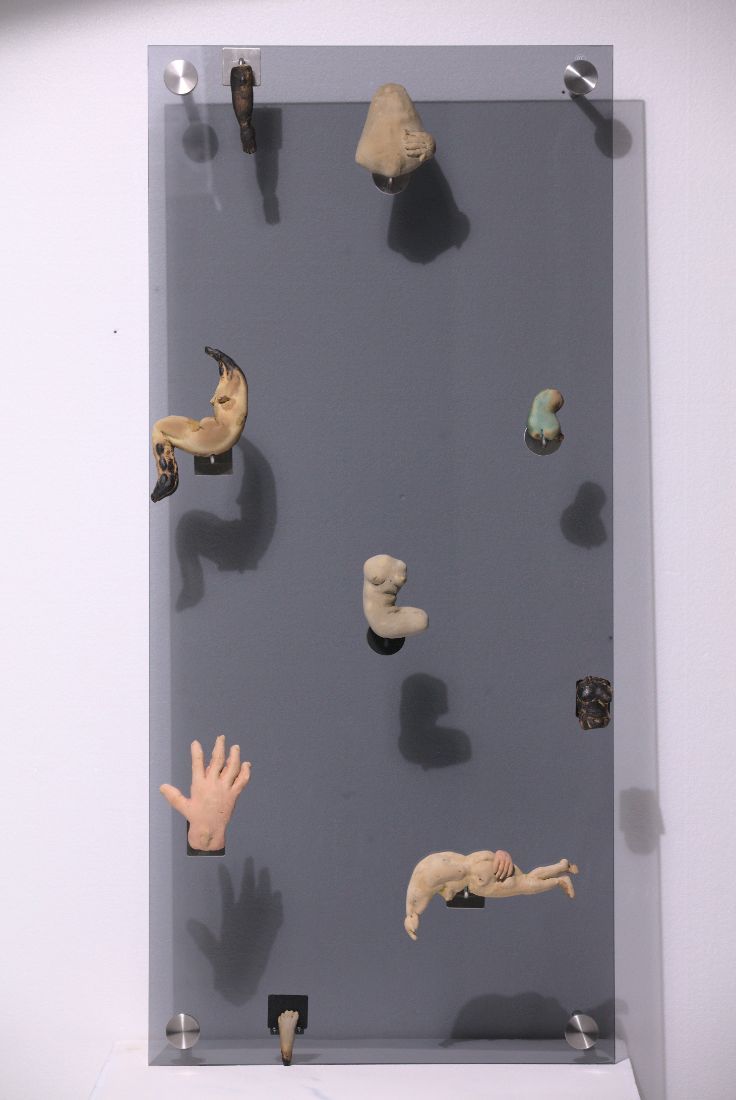
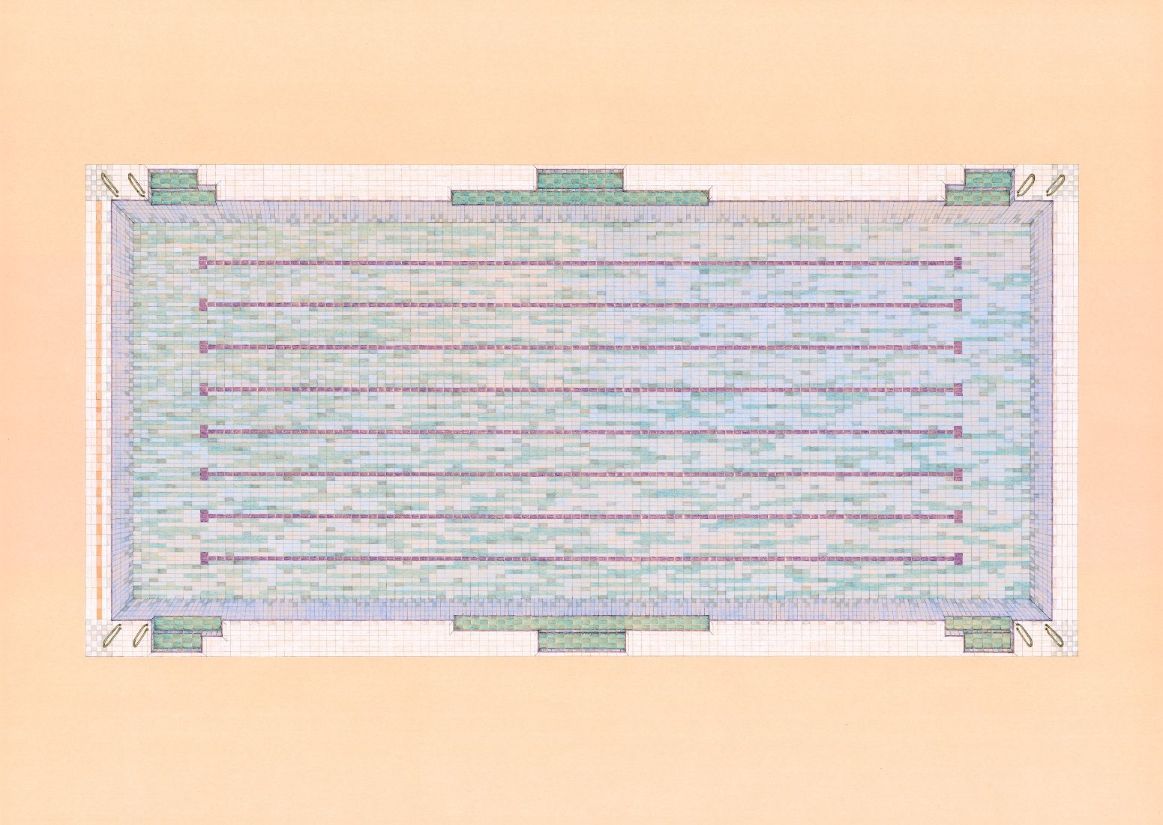
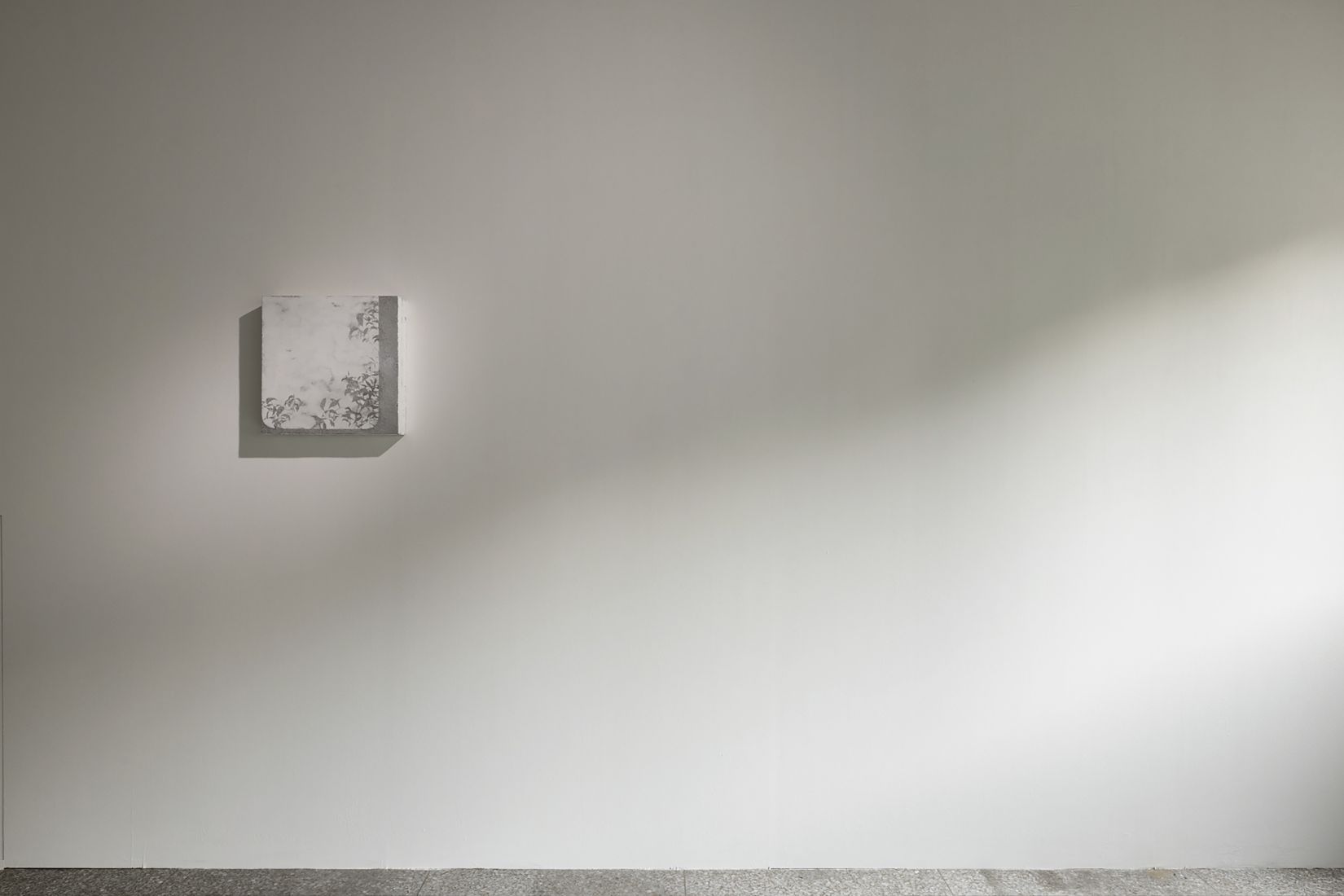
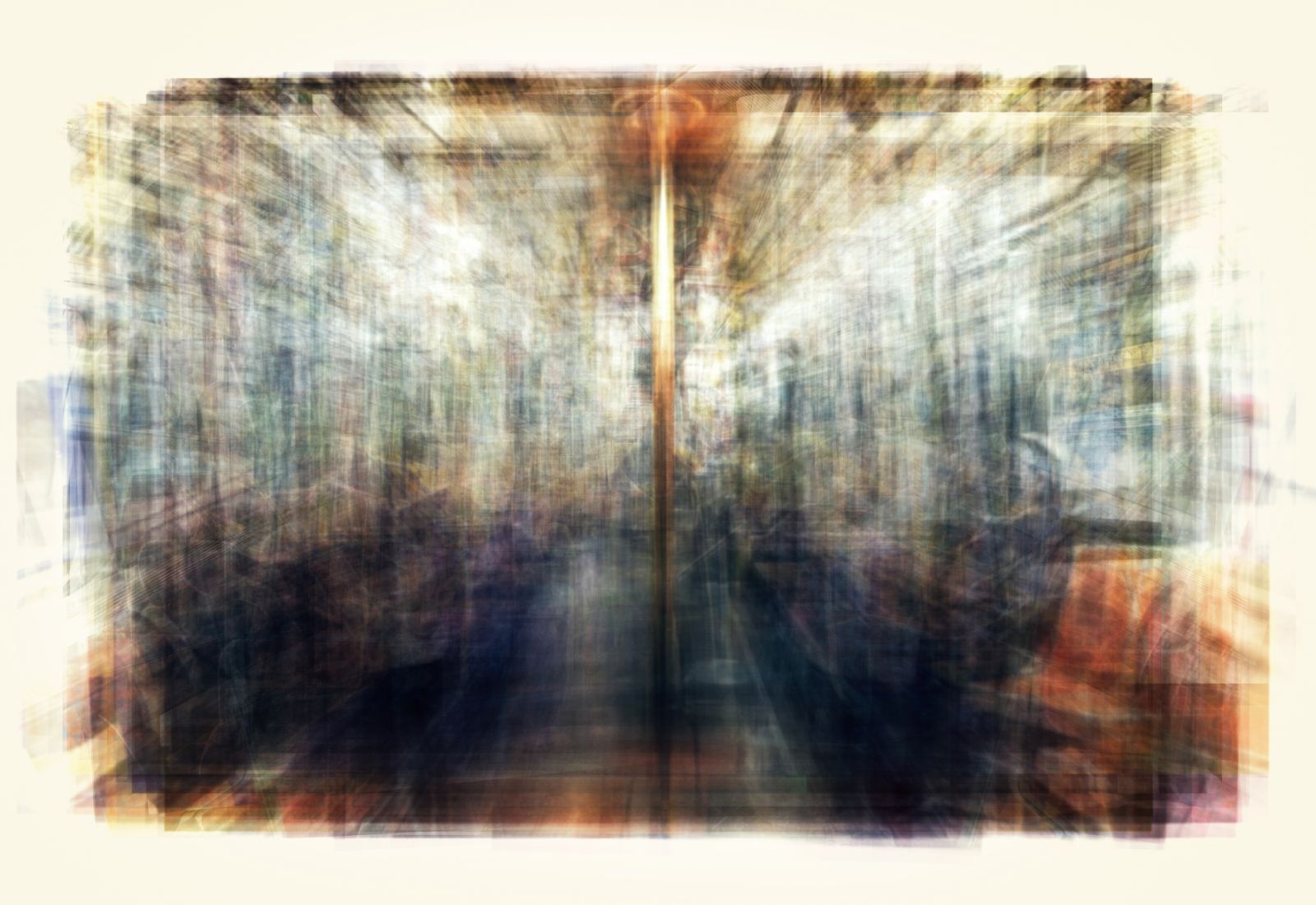
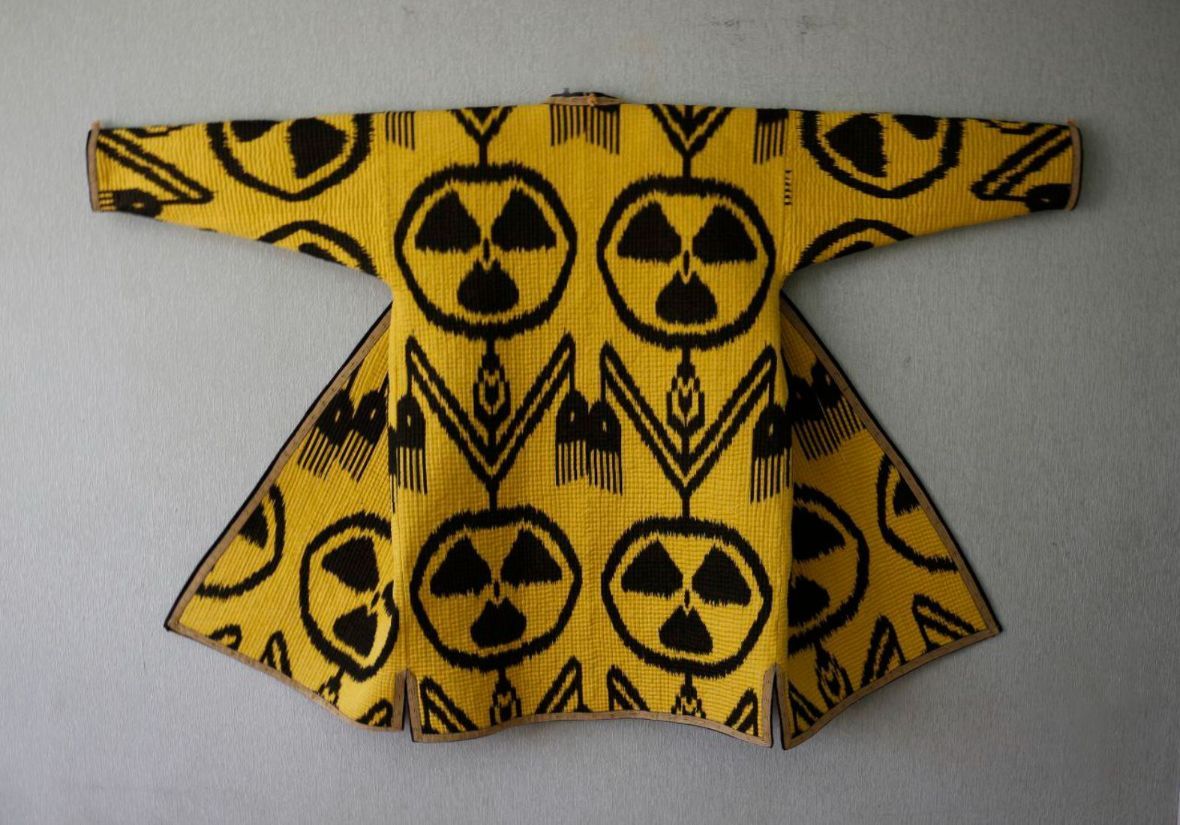
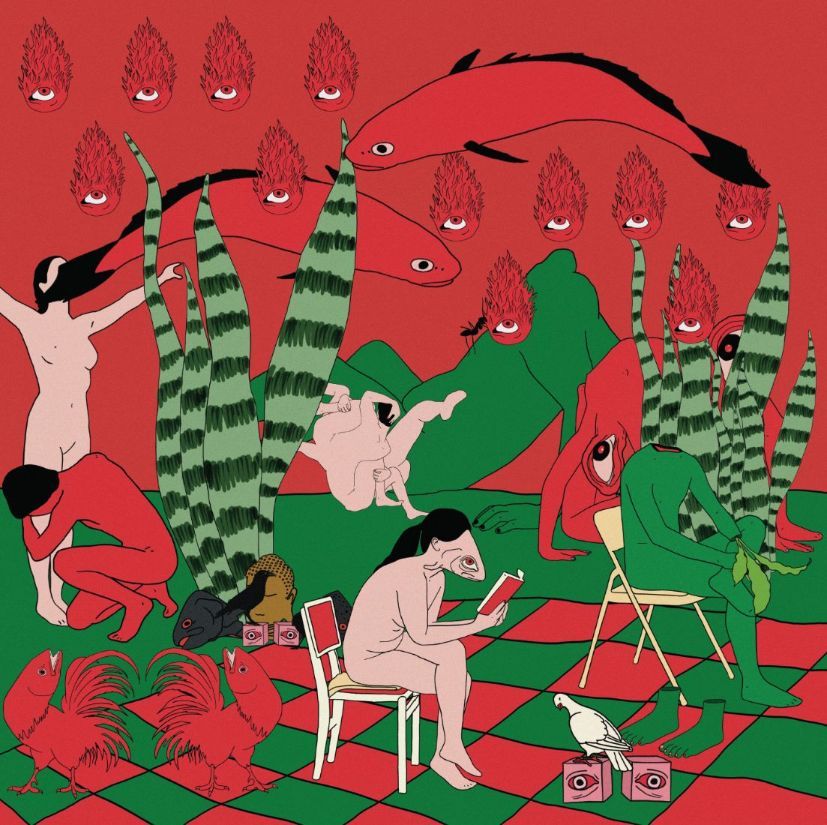
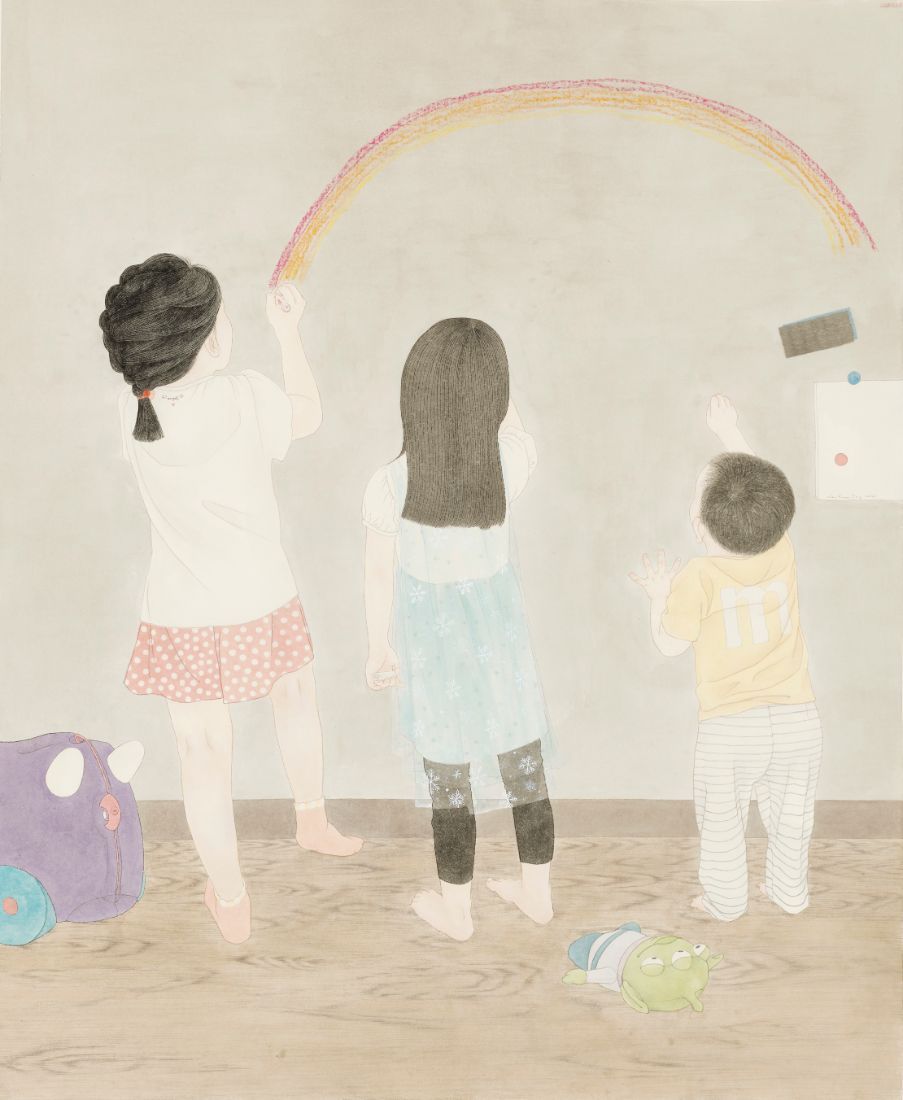
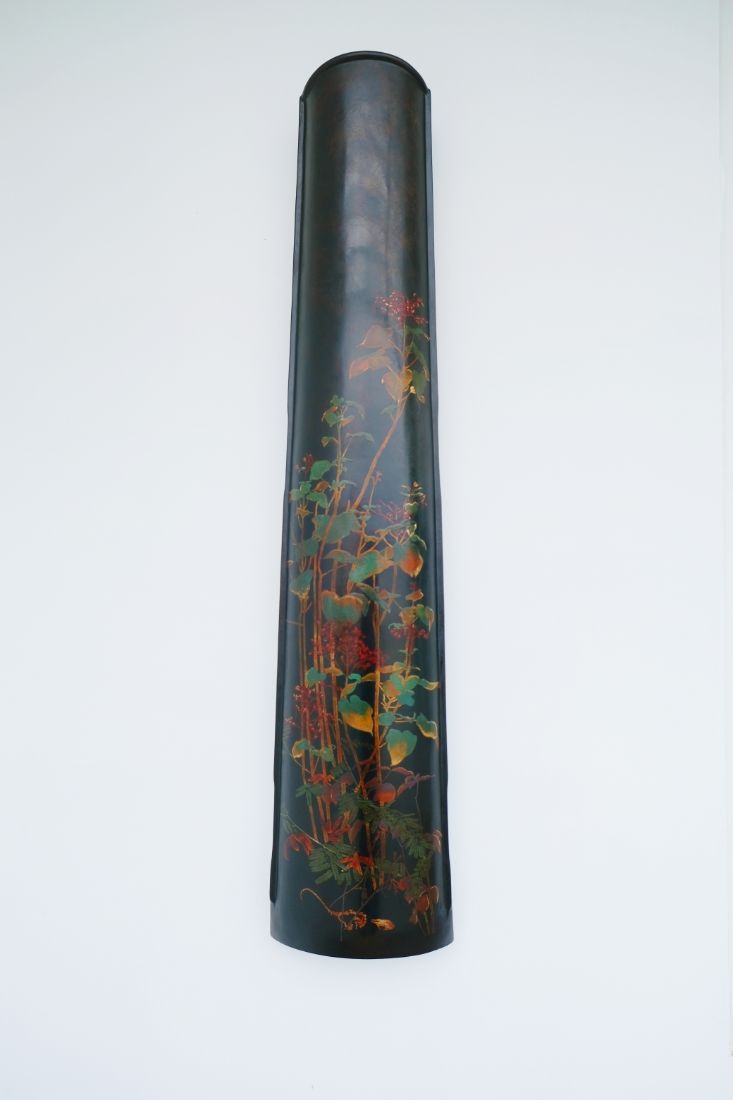
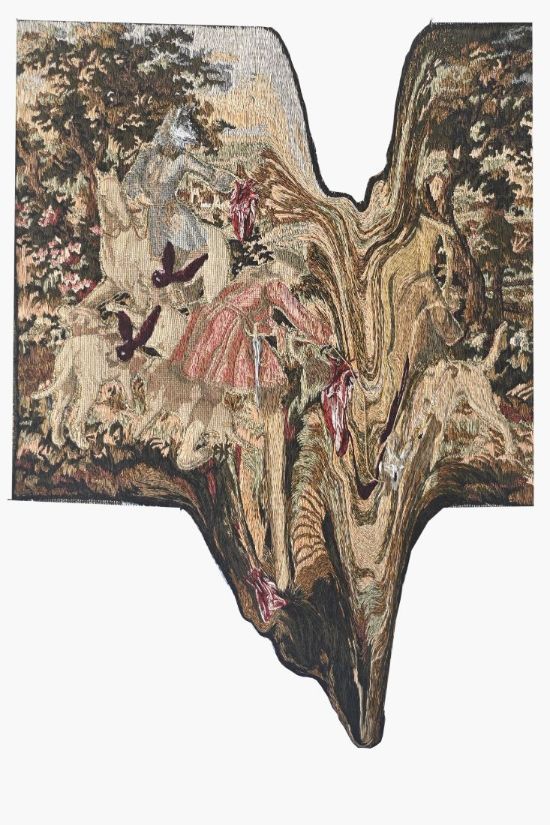
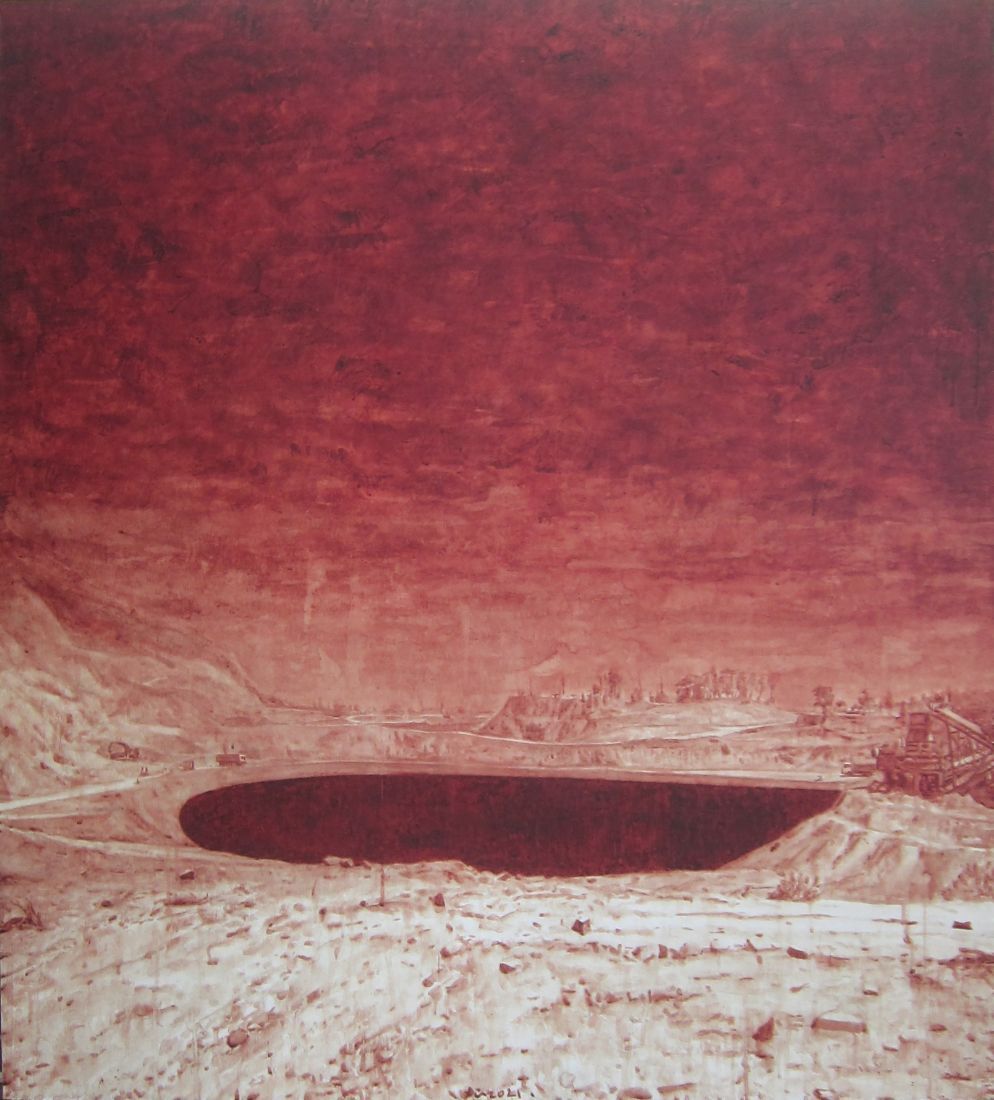
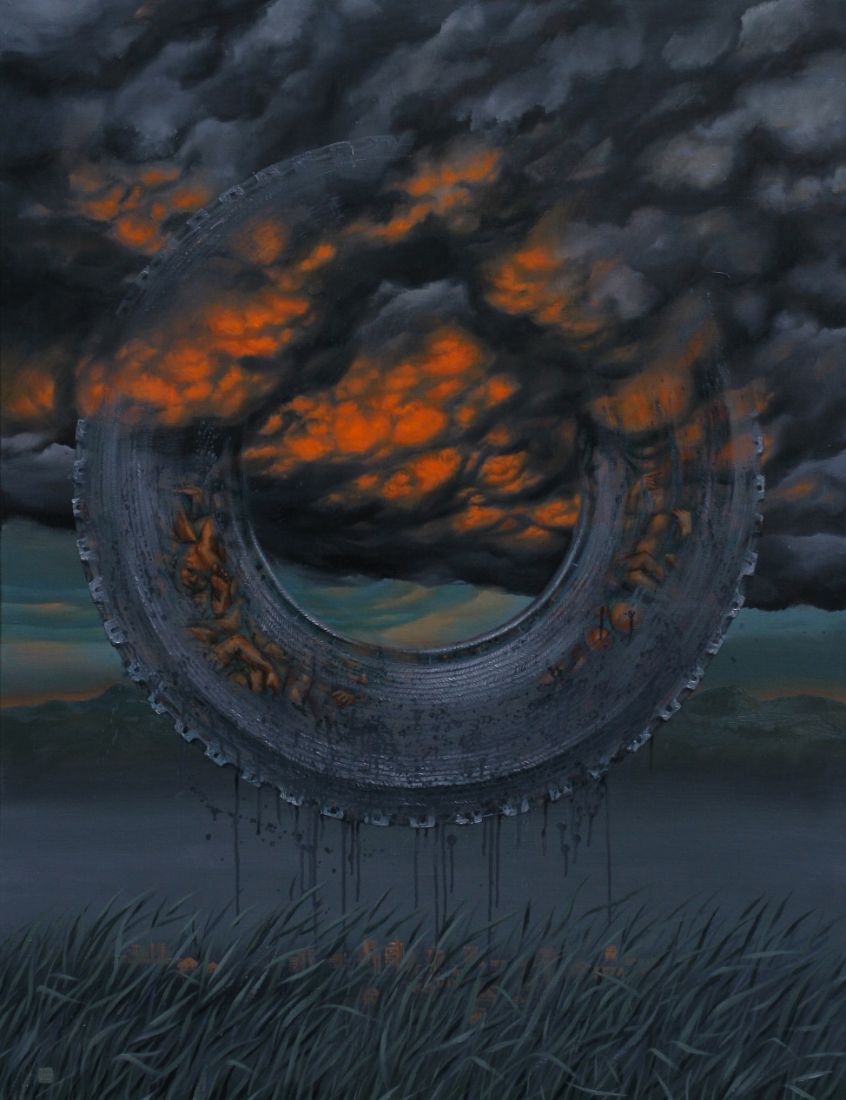
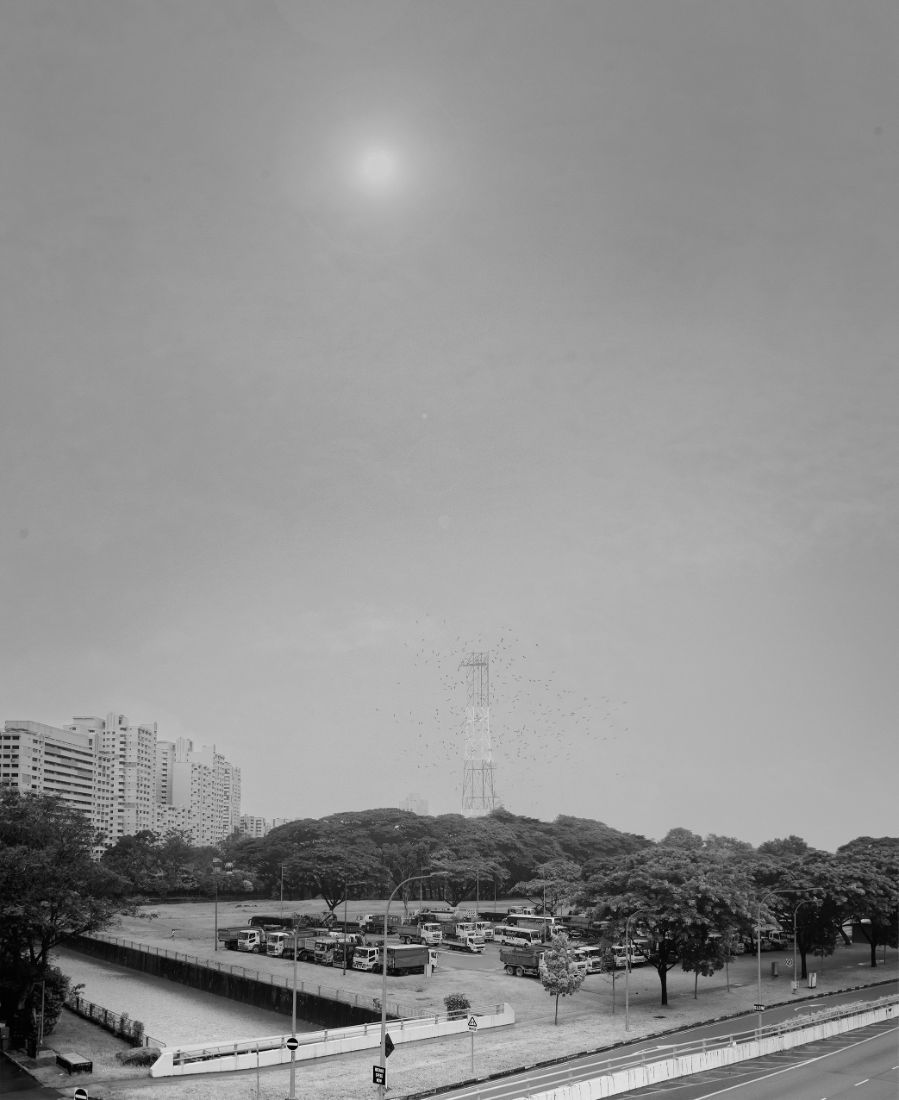
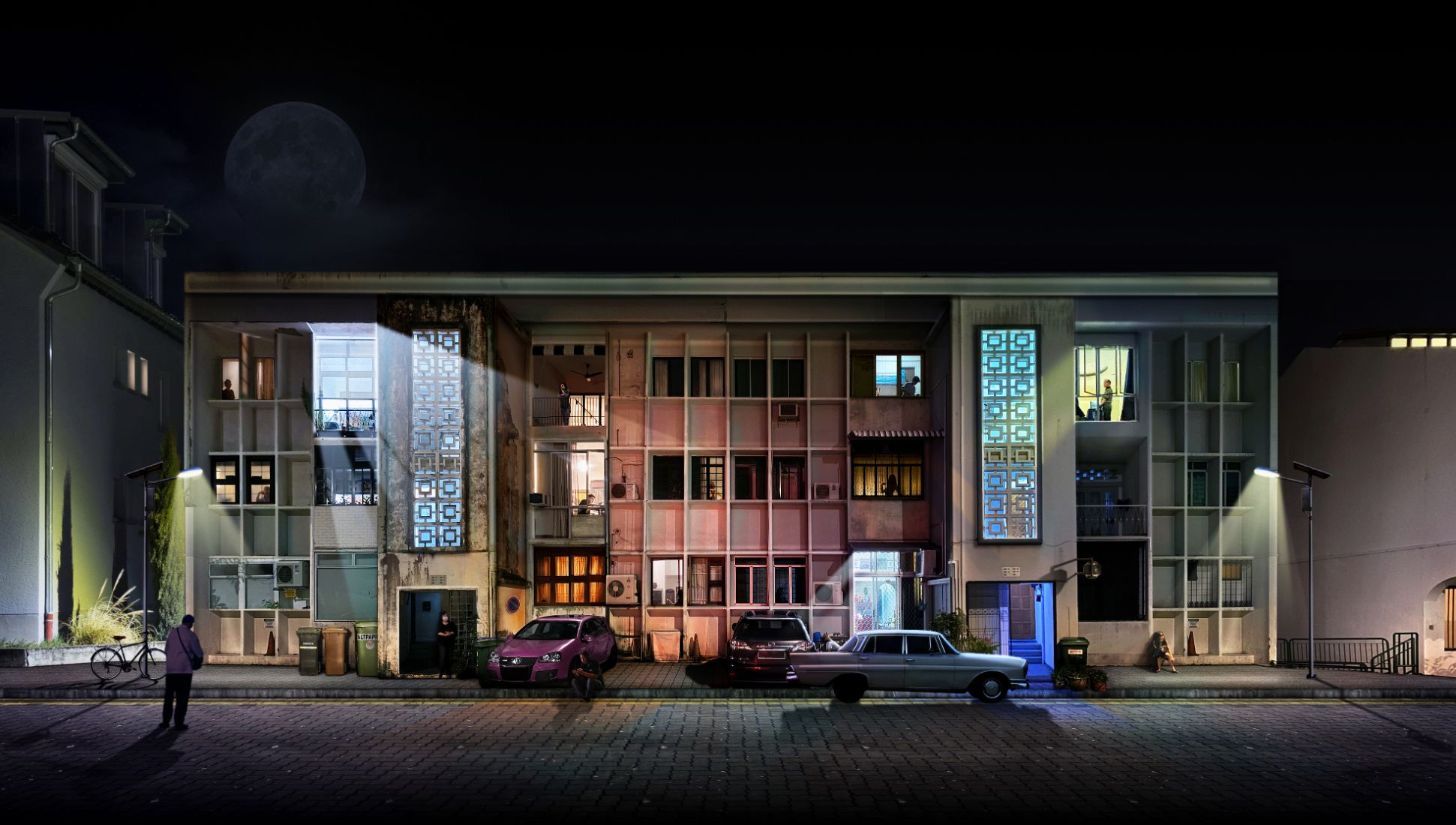
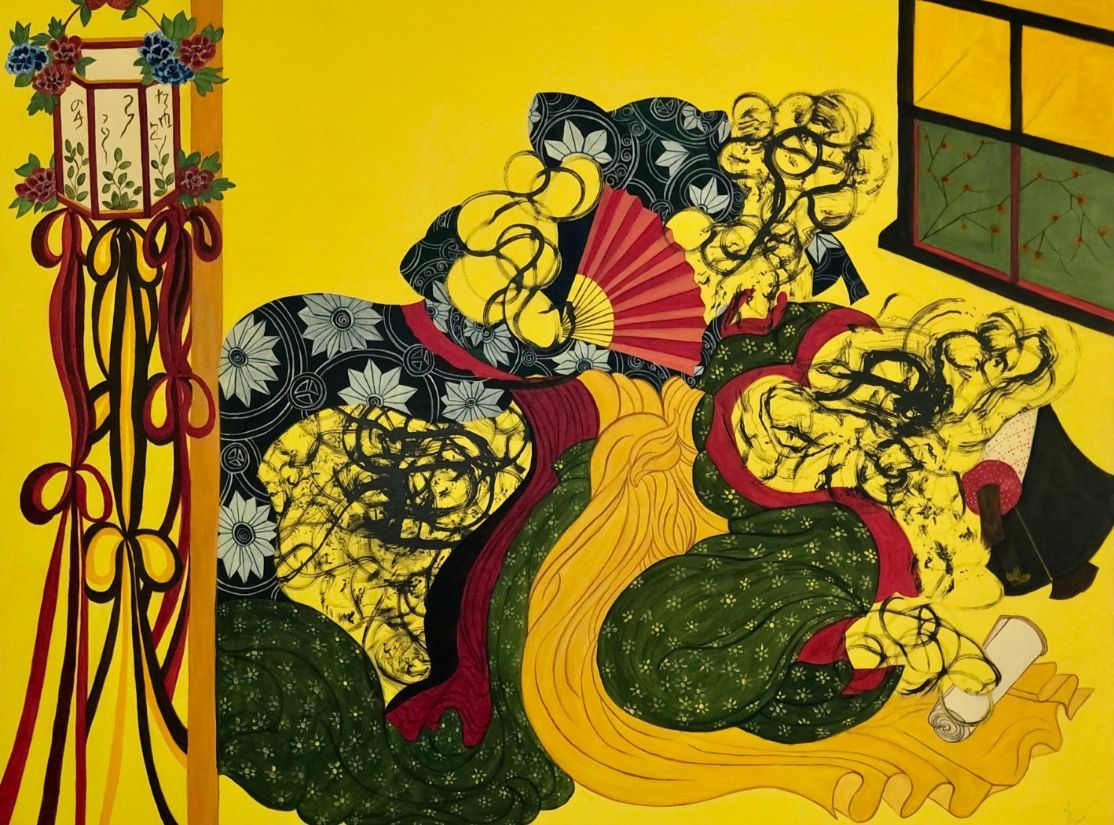
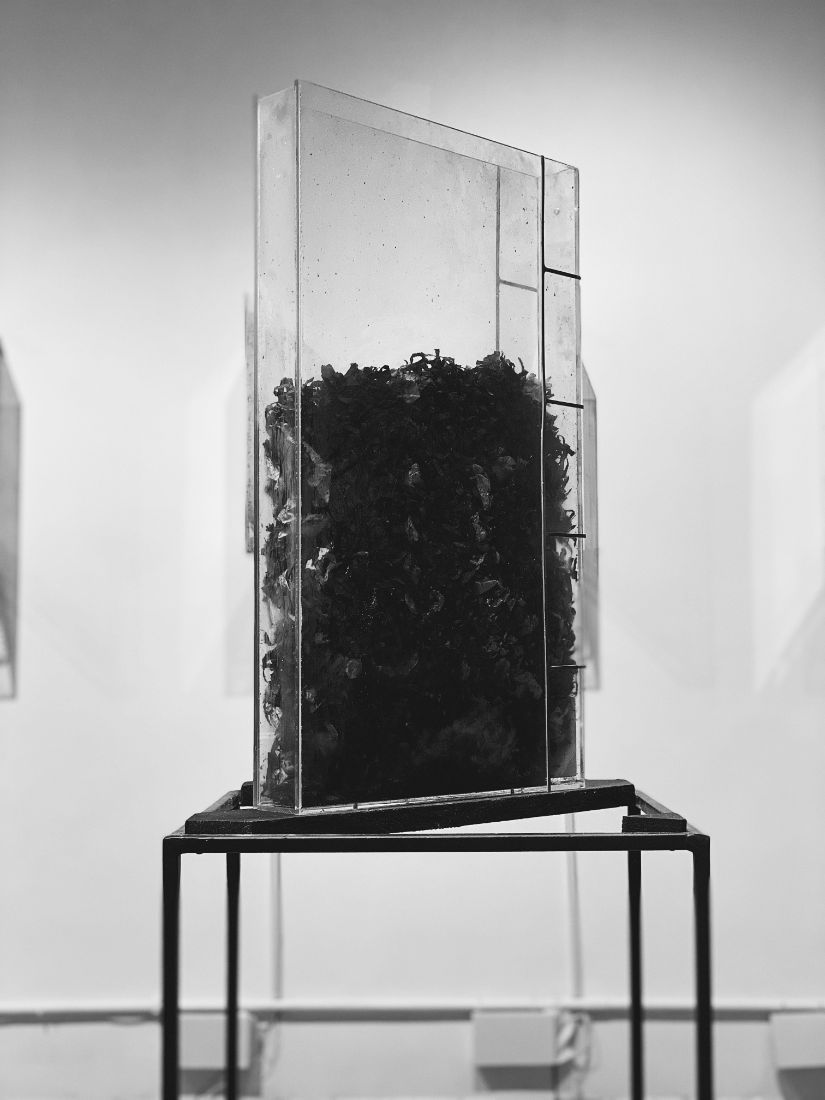
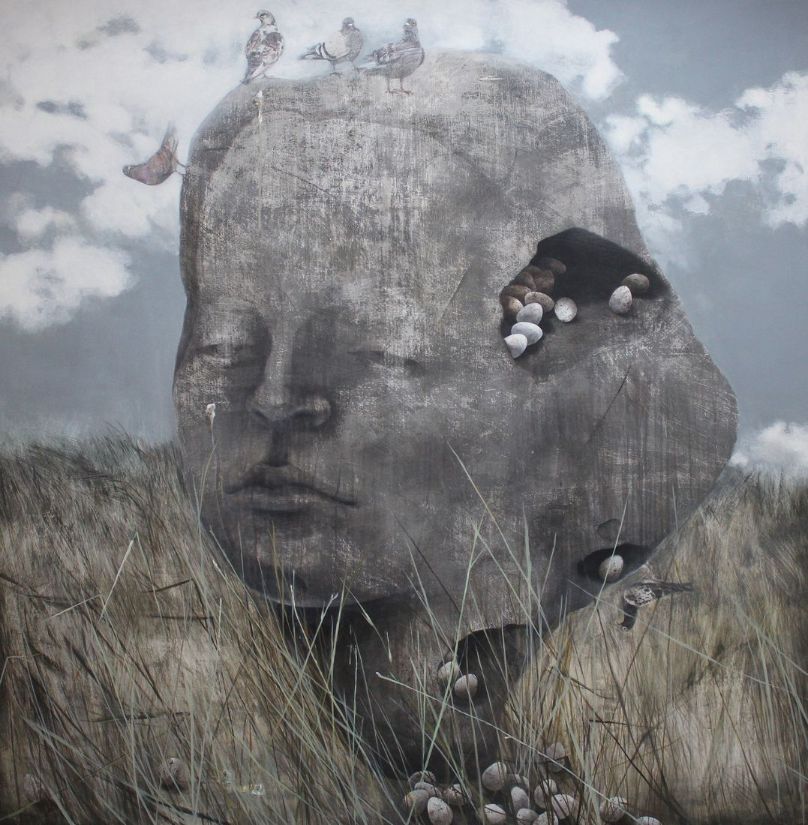
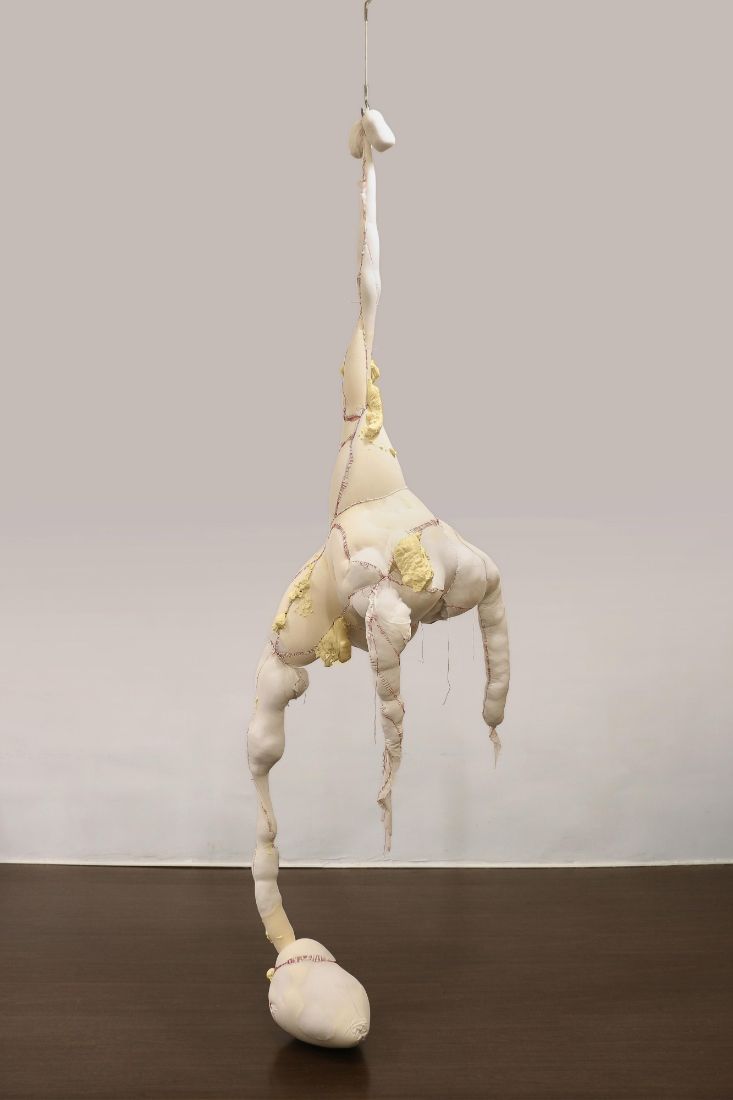


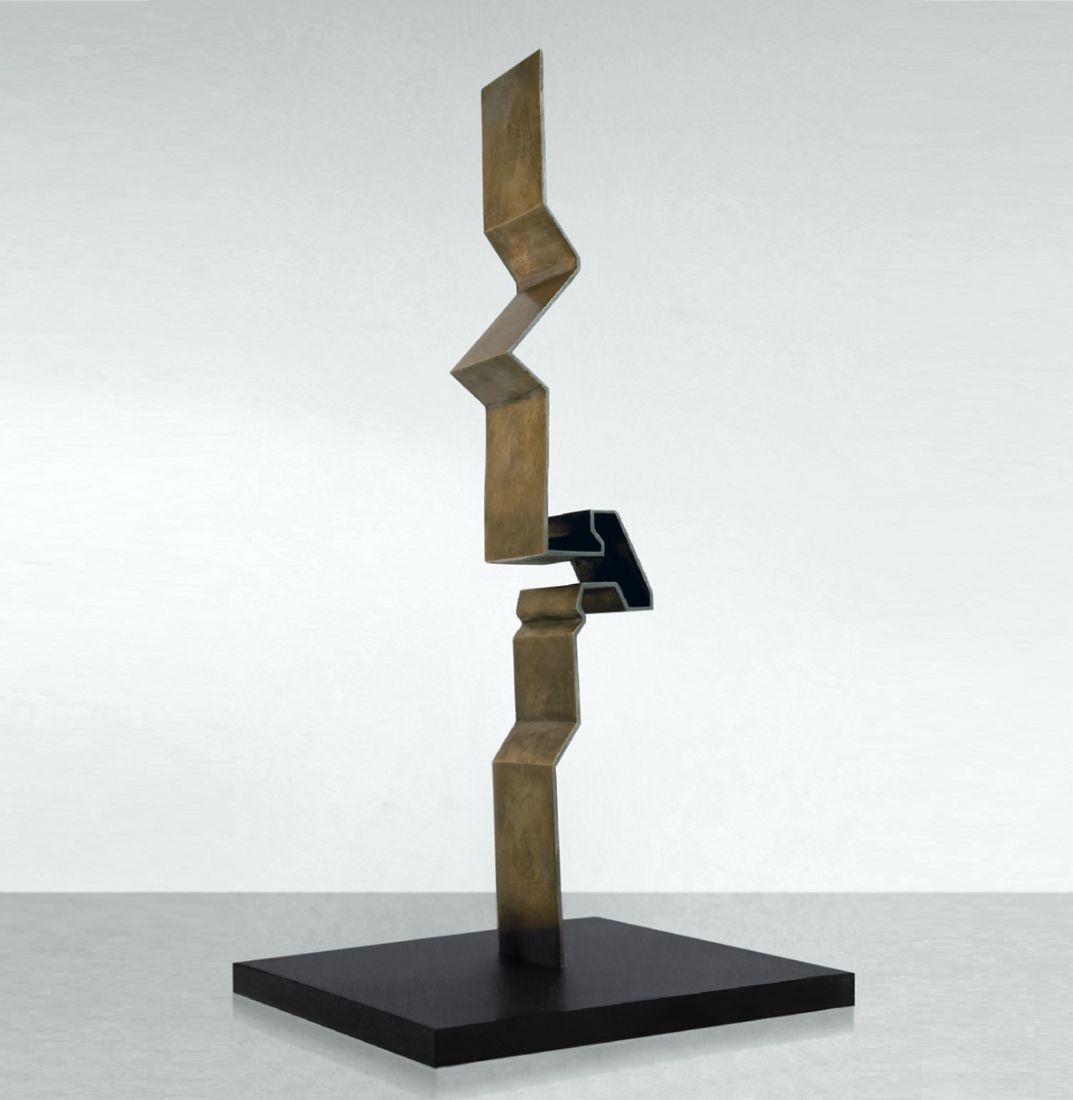



Ahn Jun (b. 1981, South Korea) holds a PHD in Photography from Hongik University, Seoul (2017), an MFA (Hons) in Photography from Parsons School of Design, New York (2012), and a BA in Art History from the University of Southern California, Los Angeles (2006). Her work aims to reveal the hidden structures beyond our visual perception of the world and of ourselves. Through photography, Ahn shows how the camera can affect our notion of reality. Starting her artistic journey with self-portraiture on high-rise buildings, Ahn interrogated her fear of heights: turning her fear into playful imagery. She continues to capture surreal moments within the context of reality.
Ahn created Self-Portrait for Vogue Korea in March 2021, when asked to capture images of spring. Coinciding with the death of her grandmother during strict Covid-19 restrictions, Ahn had not yet properly processed this loss until her family burned her grandmother’s clothes, and Ahn visited her empty house. She was struck, standing for the first time in her grandmother’s garden without her loved one. She gathered dried leaves and branches from the garden, remnants of winter, and lit a fire. To the artist, this represented sending condolences for all the springs spent with her grandmother, planting flowers, and watching them bloom: now without the person who planted the seeds.

Alvin Ong (b. 1988, Singapore) holds a BA in Fine Art from the Ruskin School of Art, University of Oxford, United Kingdom (2016) and a MA in Fine Arts from the Royal College of Art, United Kingdom (2018). His dreamlike paintings, capturing the complexities of the human form, predominantly explore themes of isolation, alienation, and desire. Characterised by blurred facial features and interlaced bodies, his work is imbued with a sense of distortion or rapid movement. By playfully combining diverse visual vocabularies, Ong draws on his own lived experience of hybridity and distance across a variety of both physical and virtual spaces.
Staycation reflects on the artist’s interest in the physicality of the body. Presented as a site of metamorphosis, the isolated body Ong depicts is glitching, intersecting, merging, and colliding, all at once, across different planes. Oscillating between restlessness and desire, the work captures the ephemerality of a collective psyche: isolated and estranged from our own skins, moving endlessly between online avatars, filtered profile images, apps, chats, and real-life interactions.

Ashfika Rahman (b. 1988, Bangladesh) holds a Professional Diploma in Photography from Pathshala, Dhaka, having also studied at the University of Applied Sciences and Arts, Hannover, Germany (2017). Straddling art and documentary, Rahman draws inspiration from historical archives, which she re-contextualises using contemporary media. Inspired by her mother, a social activist, she began working with marginalised people in Bangladesh: predominately those in tribal and ethnic groups experiencing subjugation and violence. In each of her works, Rahman aims to challenge the mainstream perspective towards these issues.
Redeem (Oraon/ওরাঁও) forms part of a body of work produced in collaboration with the Oraon community. The series engages with social issues resulting from mass religious conversion at the hands of colonisers amongst the indigenous communities of Bangladesh. Rahman worked collaboratively with the Oraon community, together sewing woven textiles from material sourced within the villages. Their essential contribution to the work encapsulates their personal ‘mark-making’ on their own territory. The final work, representing a 50-year-old topographical map of the community after the liberation war, is laced with spiritual colour theory, with colours representing the different religious beliefs that make up the region.
This artwork is available for sale but has been withdrawn from competition.

Atefe Namavar (b. 1982, Iran) holds a BA in Painting from the Faculty of Art, Shahed University, Iran (2006) and an MA in Painting from the Faculty of Art and Architecture, Azad University, Iran (2013). Her work is centred around depicting the various layers of Iranian family life. The impact of Persian literature and poetry on the imaginative nature of her painting is notable, and most clear in her latest series of work.
In the Birdhead series, Namavar took inspiration from the writings of Bijan Najdi, Iranian writer and poet, in which he states: “I cut off a bird’s head and concealed it, wanting the reader to gaze at the intensified movements and seizures of its body, wings, and feet; moments before the bird meets death and finds its movement in a state of repose, an instant of heightened fusion with life, in close vicinity of death…”. Just as Najdi, the artist considers no beginning and end for her paintings. Her vignettes, frozen in time, encapsulate the vivid nature of Najdi’s stories, allowing the viewer to clearly imagine the scene in their mind and feel the constant presence of her subjects.

Sarah Choo Jing (b. 1990, Singapore) is known for her interdisciplinary approach to photography, video and installation. Her work depicts identifiable moments and characters within contemporary urban society that suggest a plethora of private and often solitary narratives. The artist is primarily concerned with the gaze of the flaneur, voyeurism and the uncanny.
Accelerated Intimacy by Sarah Choo Jing is an immersive video installation that presents a cast of solitary figures occupying both iconic and ordinary hotel rooms across Singapore. Filmed in situ, the individuals rehearse a disjointed textual collage of found dialogue, appropriated and spliced from scripts of famous films. The artist has decontextualised these conversations and, in turn, reconstructs a potential narrative surrounding each character.
Accelerated Intimacy (Matthew and Brenda) captures two subjects shot in different hotel rooms. The characters are given the liberty of interpreting parts of film scripts and re-enacting specific roles within a set. Between the characters and their frames, Choo has carefully constructed uncanny coincidences that are incomplete, open-ended, and ambivalent. In this environment of staged intimacy, the hotel guests seemingly speak to one another, encountering each other as strangers, yet are simultaneously set apart.
Choo is an accomplished artist having been a finalist in the Audemars Piguet Art Commission for Art Basel 2020, Geneva (2019). She won the Perspective: 40 under 40 Awards, Perspective Global, Asia (2017) and came first place in Moving Images, Collage, Moscow International Foto Awards, Russia (2015). Choo is the winner of Latitude Festival 2014; The Big Screen Film Gallery, UK (2014), and winner of the ICON De Martell Cordon Bleu Photography Award (2013). The artist has since exhibited internationally at the Turku Art Museum in Helsinki (2019), National Museum of Singapore (2017), Busan Museum of Art in Korea (2016), ArtParis at The Grand Palais in Paris (2015), the START Art Fair at The Saatchi Gallery in London (2015) and Photo London at The Somerset House in London (2015).

Xue Ruozhe (b. 1987, China) holds an MA in Painting from the Royal College of Art, London (2015) and a BA in Oil Painting from the China Central Academy of Fine Arts, Beijing (2012). By changing the inner logic of the visible world surrounding us, and its relationship to our human bodies, the artist tries to intensify the psychological tension within the constructions of a painting. Xue’s work lures one into a sense of reality, then refuses it, switching instead to another realm. His canvases, characterised by a cryptic aura, skilfully emphasise the use of dark tones: casting a sense of timelessness and suspension upon the figures. The missing context of his work, very often hidden or dissipating into vagueness, eludes any plausible attempt to unravel the enigma the artist creates.
In Like, Xue hopes to create the possibility of multiple interpretations. He invites you to relish in the sense of ambiguity. The hand in front of the girl’s face seems like it is measuring, or is it giving a thumbs-up? It’s so close to the girl’s eyes that it almost seems to be touching, and yet the model appears unaffected. Thereby, tension is formed in the space between the thumb and the eye, and in the vagueness of the scenario.

Zhang Zhao Ying (b. 1988, China) studied at Brussels Institute of the Arts, Belgium (2015). His practice is centred around making elaborate manipulations over the original surface, building from past visual experiences and creating a new field where discussions and dialogues can be carried out amidst absurd narrations.
According to Zhang, today, religious myths are losing their influence. Galleries and luxury stores have replaced many functions of the church, becoming new sites of pilgrimage. However, while religious myths may no longer be attractive to society in some senses, their impact on contemporary culture is still evident today. Zhang posits that historical religious myths have provided us with our common values and language systems. However, in contemporary times, we are instead guided and transformed by pop culture. With the help of both modern pop culture and old myths, we have created a fantastic and touching world. In Myth Party, Zhang attempts to capture a reimagined site where these two worlds intersect.

Zulkifli Lee (b. 1978, Malaysia) holds an MA in Fine Art and Technology and a BA in Art and Design from Universiti Teknologi MARA, Malaysia (2013, 2000). His practice explores the dynamic between personalised and impersonalised forms, using the language of materials. His work juxtaposes the beauty and paradoxes of the relationship between humans and nature. Bridging Islamic aesthetic philosophies with contemporary principles, Lee references traditional Islamic and Malay folk art to create minimal yet intricate compositions, often involving systematic and rhythmic geometric patterns. Rather than striving for total control, he embraces the element of chance and submits to the materials’ naturally occurring properties, sharing the creation process with nature itself.
In Peripaduan (which translates to ‘Lexicon of unity’) Lee contemplates the paradoxical coincidence of opposites. According to the artist, all paradoxes can be reconciled; nature is built in opposites. In his work, solid wood and steel are interlocked and integrated in equilibrium, pulling in and out, actively nullifying the presence and the absence of shape and form. Lee views this as a process of giving and accepting: a negotiation between volume and void. Essentially, he hopes to capture the reality of our network of relationships. In these times of distance, we must remember we are a part of something larger than ourselves.

Atsuko Yamagata (b. 1982, Japan) holds a BA in Arts from the Tokyo University of Foreign Studies, Japan (2005) and completed a course in Fine Arts at Musashino Art University (2013). Her paintings transmute amorphous forms and shapes into living creatures that articulate ideas of animism or biogenesis. Yamagata explores the particularities of life through scientific imagery, such as microscopic images of cells and microorganisms. In her artistic practice, the flow of glue organically dictates the shape, allowing natural elements such as air and water to intervene and structure the composition of the work. Yamagata then determines her palette, providing definition to the shapes, each element combining uncontrollably on the canvas: becoming perfectly imperfect.
In mutualism, Yamagata explores her understanding of how the scientific structure of life relates to our human emotions. The work values a relinquishing of control, as the artist allows her medium to dictate the final form. The addition of pencil provides definition and helps emphasise certain characteristics. At the core of her work, Yamagata hopes to communicate that, even in our modern lives, we are constantly surrounded by living organisms, even if they are invisible: exploring how to accept and live harmoniously with them.

Ayessha Quraishi (b. 1970, Pakistan) works in a way natural to her since childhood, her process appearing like braille. Physically, she maintains constant contact with two materials: the surface and the paint. Quraishi’s hands perform two roles simultaneously, the right applying colour to the surface while the left removes it with a turpentine-soaked rag. This series of repeated hand gestures and motions results in a visceral language of sequential mark marking. The duality between form and formlessness, making and un-making, adding and subtracting, explores themes of memory, absence and presence, separation and union.
The day could not pen what the night painted. encapsulates the artists’ belief that the day and night are strung through a continuum of breaths; we have no memory of sleep, sensory experience or recording. During sleep, we are not aware of sleeping and only upon waking do we realise we have slept. In the absence of sensory register, the body finds rest. According to Quraishi, just as the day rests in the lap of night and its volumed emptiness, our perceptions, varnished by the light of consciousness, come to rest not in conclusions but imaginings of what life could be.

Azin Zolfaghari (b. 1982, Iran) holds an MA in Painting from Tehran University of Art, Iran (2021). Her work is characterised by unusual cityscapes depicting muted slabs of desolate façades with minimal signs of life. The only hint of a human presence comes in the form of windows, leaving the viewer wondering what the inside of the structure may hold.
Density embodies the complicated definition of “house”. Despite its seemingly objective clarity and simple framework, it is in fact a fluid concept that does not fit neatly into any physical form. Zolfaghari believes that the home is constantly changing like an organic structure. The walls may change colour, the stories may grow or shrink, or the air may become stagnant and heavy. The artist sees this as relating to the human psyche, in that we must accept the limitations of our control and surrender. Time passes from day to night through our windows, the view offering a limited horizon supposed to evoke the overall texture of the city: flat, blocked, and lacking depth. This restricted vision span wondrously closes the open space, making it blur, confined, and habitable.

Boo Sze Yang (b. 1965, Singapore) holds a Diploma in Fine Art from Nanyang Academy of Fine Arts, Singapore (1991), a Postgraduate Diploma in Fine Art from the University of Reading, UK (1995); and an MA in Arts from the Chelsea College of Art & Design, UK (2004). His work transforms banal objects, architectural interiors, and scenes of destruction into metaphors for the human condition and contemporary life. Using loose, gestural painting techniques, Boo’s semi-abstract works do not represent real moments, but instead conjure scenes where reality and fantasy coincide.
We Didn’t Start The Fire attempts to probe our perception of truth and reality. Contemplating a scene of civil unrest, characteristic of images circulating in modern media, Boo reframes reality with a sense of dark humour and exaggerated theatricality. The work, inspired by the eponymous song by Billy Joel, creates an intertextuality that enriches one’s imagination and emotions beyond the painting. Essentially, the work invites viewers to contemplate both the physical and moral battle between civilians and law enforcement, as each group tries to uphold what is right and safe for society. It is up to us to sift through the truth from fiction.

Cai Yaling (b. 1984, China) holds a is a PhD candidate in Fine Arts and a MA in Sculpture from China Central Academy of Fine Art, Beijing (2020, 2011). In her work, Cai insists on capturing genuine feelings and discovering appropriate artistic forms to present them. Her process starts with extracting words deeply experienced in daily life, then exploring in sculpture form how physical materials can correspond with these words. Through this treatment of materials, the artist feels she can naturally infiltrate the experience and perception of physical and psychological repression in the process of a women’s growth. Cai hopes to outline the endurance and resistance contemporary women use to face practical difficulties and build a base of empathy with the public.
To create Goddess, Cai used the traditional way of making steamed buns to model female body, later steaming and baking them out. These edible sculptural parts of the body swell up under the effects of high temperature and become plump and attractive. These body parts are then placed on glass plate,resembling display specimens. The work represents the generosity and dedication of women towards their families, which are often taken for granted. Behind these celebrated goddess-like bodies lies the encroachment and damage that has been overlooked.

Chan Wai Lap (b. 1988, Hong Kong) holds a BA (Hons) in Visual Communication from Birmingham City University, United Kingdom (2011). Deriving inspiration from swimming, Chan examines the duality between public and private spheres of life, delving into the essence of humanity and his inner self. The artist believes that the swimming pool, a public facility for collective leisure and sport, is a place where we feel normal exposing our body to strangers, blurring the boundary between public and private.
Pure Speculation – Tin Ka Ping forms part of a body of work portraying public swimming pools. Often created through his own experiences, Chan will count the tiles and reconstruct them on paper. Using the Lingnan University Tin Ka Ping swimming pool, shared only by the educated few, the artist questions how we define public versus private space: both in the pool setting and at a university in general. Without free access to university pools, Chan mined for images and data on the internet and launched his first series of swimming pool drawings created from his research and imagination.

Chiu Chen-Hung (b. 1983, Taiwan) holds an MFA in Plastic Arts from the National Taiwan University of Arts, Taiwan (2008). Working primarily in installation and sculpture, Chiu creates his art as if conducting an archaeological expedition. He is especially proficient in excavating the remaining outlines and imprints of bygone eras. Through his practice of abstracting and reinterpreting both designed and rationalized logics, he vividly reshapes existing objects and thus develops a vast restoration of memory. Comprising concrete and putty, Daylighting captures a view through a window of an abandoned military base, dappled with foliage. Through a repeated process of polishing, carving, and mending, the artist conjures three-dimensionality from his materials. Fragments of light and shadow form silhouettes of foliage and coalesce into a poetic vignette. Rendered in almost classical techniques, commonplace construction materials transmute into a melancholic portrait of desolation and surveillance, wilderness and romanticism. At its core, Daylighting captures a fleeting moment, irrevocably engraved into pallid concrete.

Cyrus Tang (b. 1969, Hong Kong) holds an MFA from Monash University, Melbourne (2010) and a BA (Hons) of Fine Art from Victoria College of the Arts, Victoria (2004). Depicting scenes of ruin and decay, her work deals primarily with loss of memory, characterised as the dust of civilisation drifting in a black void. Tang contemplates the tension between forgetting and remembering; this is mirrored in her creation process where her initial images are captured using modern devices and reworked through labour-intensive means in her studio. This manipulation represents the ruin of memory, and yet is what Tang pins her hopes to for resurrection or survival.
According to Tang, while wars have victors, pandemics leave only the vanquished. Believing it important to memorialise this time, she hopes to capture our collective experience. During the pandemic, the artist experienced seven lock downs in Victoria – the most frequently locked down city in the world. Deserted city life inspired her to create Carriage. The vessels of public transport, once bustling with people, now stand empty. By layering multiple images into one, the original image disappears into the composition – just as the rigid routines of our days blur into one.

Dilyara Kaipova (b. 1967, Uzbekistan) holds a BA in Design from Republic Art College, Uzbekistan (1990). She works primarily with Uzbek textiles: imbuing contemporary meanings onto its centuries-long traditions. Through her art creation, Kaipova renders her medium relevant to the current socio-cultural and ecological problems of the region and its post-modern history. She sources and uses vintage fabrics from the Soviet area and homemade embroideries, around which she structures her new narrative.
Yellow Steppe Danger Signs evokes this conversation between ancient heritage and recent history. Locating the intersection between folk artisan traditions and contemporaneity, the artist designs original patterns and produces her ‘Ikat’ fabrics in collaboration with traditional masters. While the production method may be centuries old, her colour palette and patterns are distinctly modern, showing how heritage can be absorbed and perhaps even devalued by symbols and cliches of mass culture. However, Kaipova also wishes to communicate how these same cliches can invigorate and transform traditions which are constantly evolving, independent of our influence.

Kyaw Htoo Bala (b. 1992, Myanmar) holds a Diploma in Fine Arts from Lasalle Collage of The Arts Singapore, Singapore (2017). Through his multi-media practice, he reflects on contemporary issues. Adopting a surrealistic approach, Bala uses painting, photography, printmaking, sculpting, videography, and digital art to convey his messages. In 2018, he began working as an art director in TV and film. Just one week before making his first film, the tragic coup took place in Myanmar. Overnight, his hopes turned into despair, as he now found himself surrounded by violence, chaos, and uncertainty: emotions he channels into his work.
Referencing the worsening situation in Myanmar, The Reader reflects on the artist’s struggle to cope with the chaos surrounding him. He feels that his community, dreams, and freedoms have been shattered. Despite not being physically harmed, Bala feels like a prisoner in his own country, with desperation and frustration becoming his new normal. Searching for refuge in media, he stumbled upon an image of Aung San Suu Kyi reading a book during her house arrest. Bala was struck by how calm she appeared despite her freedom being stripped away. He realised that suffering can be managed if our minds stay focused and tranquil. By summoning focus and creating The Reader, the artist has begun to accept reality and move forward.
This digital artwork was printed in Hong Kong. Exhibition of the artist’s original submission, an acrylic painting, was prevented due to the current political situation in Myanmar.

Lai Kwan Ting (b. 1985, Hong Kong) holds an MFA in Chinese Art from The Chinese University of Hong Kong (2011). According to the artist, art is an expression of passion for living, a sign of respect towards life, and a response to the creation of God. Her artistic practice involves using ink and ‘gongbi’ technique to paint animals, nature, and portraits: depicting scenes of everyday life in loving detail.
Draw Something adopts the traditional and meticulous style of Chinese painting known as ‘gongbi’. According to the artist, drawing is the art of representing a thought in one’s mind, especially for children. Draw Something encapsulates Lai’s appreciation for children’s creativity and hopes to bless their future, encouraging them to perceive the world in their own bright and wonderful ways. Initially inspired by her children, Miriam and Moses, Lai saw how freely they were able to express themselves when drawing on a blackboard. In art, there are no rules, no boundaries, no limits – not like reality. The work captures a rainbow of lively colours reflecting the joyfulness and goodness of us all. The artist asks us to consider: when was the last time you sat down just to Draw Something?

Le Thuy (b. 1988, Vietnam) holds a BA in Fine Arts from Vietnam University of Fine Art, Vietnam (2013). She sees her work as a witness of the times, reflecting contemporary events through a personal lens. Haunted by death and destruction, Le wrestles with moments of death and their stories. The artist believes that the desperate struggle to merely exist is reflected in the behaviour and origins of a people. In bearing witness to personal tragedies, Le admits that she cannot fix anything, just hope for salvation and a better future. Through silk, lacquer, and an Eastern aesthetic, she expresses her thoughts.
Garden of Eden is part of a collection entitled “The Silence is deafening” (2020), referencing the tragic event where 39 Vietnamese people were found dead in a refrigeration truck in England. To change their lives, they traded their lives. Finding a broken zither instrument called a ‘Dan Tranh’ that could no longer produce sound, the artist removed all the sound-producing elements and used lacquer to paint a lush and peaceful garden, with only a dry rat skeleton lying exposed. The now silenced instrument, with its veneer of loss and loneliness, stands in quiet testament to those people of no status, who have no voice.

Marium Agha (b. 1982, Pakistan) holds a BFA from Indus Valley School of Art and Architecture, Pakistan (2006), an MFA from University of The Arts London, Central Saint Martins, London (2009), and completed a course in Curating Contemporary Art from Chelsea School of Art And Design, London (2009). By surveying the relentless nature of love for over a decade through images, theory, and the self, the artist finds a safe process in deconstructing elements of popular culture which no longer validate contemporary sensibilities. Agha’s deconstructed tapestries, drawings, and text serve to create newer, relevant narratives of the ‘given real’, that is, love, and the supposed representational: the concupiscence of the flesh.
HEAR HEAR is accompanied by the following text from the artist: “Hear here Feed it to the dogs You know who you are Flesh is weak, love is lust, Look away and let it drown Tear, pull, push and discard You will drown, nothing will last Hear here Feed it to the dogs”. Created using found tapestries from a Karachi flea market, Agha has deconstructed the fabric and altered the weave to create a new narrative. Each thread is then meticulously carved into the existing surface with an “ari” (embroidery needle).

Nguyễn Văn Đủ (b. 1986, Vietnam) holds a BFA in Painting from Ho Chi Minh City University of Fine Arts, Vietnam (2012). His paintings explore notions of personal perception surrounding the impact of education, daily Vietnamese habits, moral questions behind nationalism, and the violence that often follows in pursuit. Nguyễn also questions the ethics behind animal cruelty and consumption. He points to modernism’s radical plunder of natural resources, hoping to raise awareness and invite conscious reflection. The artist’s preferred medium is cow and human blood on various surfaces.
Today’s landscape (The Land of Holes) No. 01 depicts a quarry at Dinh Mountain in Vietnam, dating to the French colonial period and still exploited today. ‘Land of Holes’, coined by activists, refers to Caserta, Italy, where former marble quarries have been filled with garbage and levelled with green, artificial grass, giving the appearance of phony mountains. Reminiscent of Palaeolithic cave paintings, Nguyễn has used his blood not only to express his love for his homeland and preserve his DNA, but also to acknowledge a history of brutality and death resulting from nationalism and national pride. Conversely, 24k gold glitters in the sky, symbolising glory.

Pham Huy Thong (b. 1981, Vietnam) holds a BA in Fine Arts, Major in Graphic Design, from Hanoi Industrial Fine Arts University, Vietnam (2004). Having grown up with two journalist parents, he was absorbed by many adult discussions about literature, society, and politics from a young age. As a result, his work as a visual artist centres around the societal and the political. Creating such work does come with its challenges, however the difficulties that arise only serve to inspire the artist.
Reincarnation Wheel 1 forms part of a series entitled ‘Reincarnation Wheel’. Initially, the artist set out to depict the story of 39 Vietnamese people who sought a better life in England but were instead found dead in a lorry. However, when facing the canvas, Pham found his thoughts drifting far beyond the tragic case. Essentially, the work takes inspiration from all our lives, whether we are rich or poor, as we fight every day to pursue happiness.

Robert Zhao Renhui (b. 1983, Singapore) is a multi-disciplinary artist and founder of the Institute of Critical Zoologists. His artistic practice addresses the human relationship with nature.
And A Great Sign Appeared (Things from the Heat) captures a moment on 22 December 2019, when thousands of birds suddenly appeared in Singapore. They were Asian Open Bill storks: birds foreign to Singapore. Having come from northern parts of Southeast Asia, the storks flew around Singapore for a week looking for a new home. However, they were unsuccessful and left. Through his work, Zhao Renhui wishes to portray the major ecological shifts that Southeast Asia will continue to experience as a result of climate change. The mass appearance of Asian Open Bills in such great numbers serves to remind the audience that our regions are all connected ecologically, and we can be affected in the most unexpected ways. Their flight is just one example of how a highly visible, regional species is reacting to this ecological change. The artist notes that Mainland Southeast Asia is experiencing one of its worst droughts in years, which may have caused the storks to fly off in search of new territories.

Sarah Choo Jing (b. 1990, Singapore) holds an MFA from the Slade School of Art, London (2015). She is known for her interdisciplinary approach to photography, video, and installation. Her work depicts identifiable moments and characters within contemporary urban society that suggest a plethora of private and often solitary narratives. The artist is primarily concerned with the gaze of the flaneur, voyeurism and the uncanny.
Formerly a plantation land in Singapore, Emerald Hill was subdivided as housing for wealthy Chinese and Straits-Chinese merchants at the turn of the 20th Century. Most independent mansions have since been demolished, the area now housing a variety of businesses. However, 156 Emerald Hill remains a residential block. In her artwork, Choo captures a digital composite of memories recorded during the Circuit Break in Singapore resulting from Covid-19. Hovering on the border between objective and subjective, public and private, the image presented is a culmination of momentary openings – of pockets in between. A transitory site, 156 Emerald Hill sets the stage in depicting ignored seams and forgotten vistas, promising a utopian and apocalyptic site.

Dipali Gupta (b. 1977, India) holds a BA in Fine Arts from McNally School of Fine Arts, LaSalle College of the Arts & Goldsmith University London, Singapore (2018). Her experimental work, influenced by Foucauldian biopolitics, religious habituations, socio-political constructs, and Donna Haraway’s Cyborg questions societal constructs of the feminine domain and strives to reclaim space and meaning. Her research lies in feminist theory and identity politics, aiming to defy myths of femininity, such as domestication and reproduction, and subvert notions of the patriarchy. The absence of the female body in her work ruptures the signifier of female sexuality which is traditionally objectified for the male gaze.
Lovers and A Lantern, part of Gupta’s ‘Pages from the book of Spring’ series, fuses abstract vibrator drawings with historical erotica of the Japanese Shunga. Traditionally, Shunga depicted heterosexual relationships, eroticising and normalising the act of sex. Through her work, Gupta explores and re-interprets these aspects of early Eastern pornography as feminine assemblages of body and machine. Her work builds from a history of female objectification and reclaims space for female desires and pleasure, and regenerates history from an alternative standpoint. The black ink marks, representing female sexual desire and the body, are created with household tools which signify and reject feminine ideologies of domestication and the private.

Chris Cheung (aka. h0nh1m) (b. 1983, Hong Kong) is best known for installation art and audio-visual performance, whose artistic expression depends upon electronic, sound, image, and creative technology in new media. His reverence for Eastern and Western philosophy are central to his practice, which blends traditional ideology and futuristic imagination to create immersive soundscapes, generative art, and data art.
The Book of Ashes is inspired both by dystopian novel Fahrenheit 451 by Ray Bradbury and a quote by poet Juan Ramón Jiménez: “If they give you ruled paper, write the other way”. Bradbury’s novel, set in an imagined future, depicts a controlled, oppressive society in which the government orders the burning of all literature: preventing revolution and free thinking. h0nh1m’s work empowers the participant to reconsider what matters to their life. Comprised of magical flash papers, participants are encouraged to write down their words, then drop the flash paper into the container equipped with a heating wire for burning. The flame wavers in the vessel, the words on the pages falling like a snowy feathers, forming a collective work of ashes.

Faezeh Baharloo (b. 1988, Iran) holds a BA in Painting from the Department of Art & Architecture, Isfahan University of Art, Iran (2012) and an MA in Illustration from Tehran University of Art, Iran (2014). Through her paintings, Baharloo combines indoor and outdoor elements and exposes their deterioration into one another. She utilises a free association technique, deforming the human body with natural objects, thereby creating a paradoxical composition that, at first glance, appears to be still life work. Essentially, Baharloo wishes to communicate that humans are not destroyers of nature, but are themselves a part of nature teetering on the edge of self-destruction.
Untitled 1 is a work of decadence, aiming to show both the human body and environment in an ideal and otherworldly form. According to the artist, our bodies, souls, and morality are going to dissolve and disappear. Her work contemplates the chance of a rebirth, perhaps alluded to by the presence of birds and eggs. However, this metaphor may not necessarily be one of optimism; to Baharloo, Untitled 1 hints to the history of a falling civilisation.

IV Chan (b. 1978, Hong Kong) holds a Master of Fine Arts from The Chinese University of Hong Kong, Hong Kong (2020); a Post Graduate Diploma in Fine Arts from Goldsmiths, University of London, UK (2003); and a BA in Fine Arts from Maryland Institute College of Art, USA (2002). Her practice is rooted in the complex relationship between the human body and the soul. Chan inspects our inescapable corporeal existence and seeks new potential in mortal flesh, exploring the relationship between Man’s original sin and catharsis, as well as concepts of death, sex, sacrifice, violence, taboo, religion, and mythology.
Another Hangover of Adam is part of a series that focuses on transforming materials into sculptural reinterpretations of anatomical metaphors. It attempts to revisit and reimagine the beauty of corporeality. Throughout life, our bodies experience myriad ruptures, temporary disturbances, and wounds, and are constantly altered as they heal and denote these experiences. Such occurrences surpass the physical and instead encapsulate the wonders of renewal, growth, and rebirth. The magical process of healing not only indicates our past but also provides a vestige of human vulnerability which must be venerated as a sacred space in allowing one’s development of identity.

Kurt Tong (b. 1977, Hong Kong) holds an MA in Documentary Photography from London College of Communications, University of Arts London, London (2006). He is primarily concerned with exploring his Chinese roots, mythology, and folk religion. Recently, the artist has undergone projects to reconnect himself with his past: dealing with the story of Hong Kong and the Asian diaspora through the lives of his own family and his nanny.
Is Life Worth Living? forms part of a much larger project entitled ‘Dear Franklin’, an elaborate visual narrative that is both a doomed love story and a ghost story. The story takes place between a man from humble beginnings, now part of the 1930s Shanghai social elite, and a daughter of a high-ranking Chinese general, known only as ‘Dongyu’. The work explores cultural identity and belonging through multi-layered narratives that use both the artists’ own and found materials. Thereby, a new narrative woven from existing narratives is born. Tong’s work operates in the hinterland between the real and the imagined, dealing with war, forced migration, social mobility, tragic loss, Taoism and ghost marriages and at the same time, deftly addressing the ambiguous nature of photography itself.

Jel Suarez (b. 1990, Philippines) is a self-taught artist who sees herself primarily as a hunter, gatherer, de/constructor, and arranger. Built on a practice of collage-making, her work is openly informed by the physicality of things. Being composed of natural objects, such as paper, stones, and other salvaged materials, Suarez’s works release objects from their old lives and engage them in a process of ‘becoming’. Her work doubles as cartography: an unconscious mapping of images and materials into differing landscapes that allows viewers to engage in non-linear interaction with the work.
Folding a Landscape takes the form of a 56-page accordion featuring collages and markings in rhythmic stone and mountain forms, displayed in a cave-like stance. Writing back and forth with cut-outs, Suarez created a tangible record of her longing to return to her home province during the height of the pandemic. Working intermittently, she navigated the uncertainties of the time and created a portable landscape that can be carried and expand to fit different spaces. On the book’s casing, these words are engraved: “a labyrinth leading nowhere but into itself — folded evermore”.

James Geurts (b. 1970, Australia) holds a Post Graduate degree from GEMAK Institute, The Hague, Netherlands (2011), an MA of Arts from RMIT, Australia (2009), and a BA in Art and Design from Swinburne University, Australia (1991). His multidisciplinary, conceptually-driven practice is developed through abstraction, fieldwork, site interventions and studio research. Geurts focuses on the way that cultural and natural forces intersect to shape both landscapes and perceptions. His site-actions include modifying analogue and digital methods to emulate conditions of the site. His recent projects explore the diversion of river agency, study the seismic, and investigate concepts of time.
Time Zero: International Dateline is based on a constructed geopolitical line drawn from the North Pole to the South Pole, at 180° longitude, demarcating one global calendar day from the next. This earth-scale project marks the time interval of ‘zero’, giving material form to an invisible phenomenon. Cast in the ancient material of bronze, the sculpture connects a pre-modern age with industrial era time zones. Through his work, Geurts references the historical redrawing of this imaginary line and expands upon ancient ways of understanding light and time through the creation of forms such as the Easter Island Stone sculptures and Stonehenge.




































